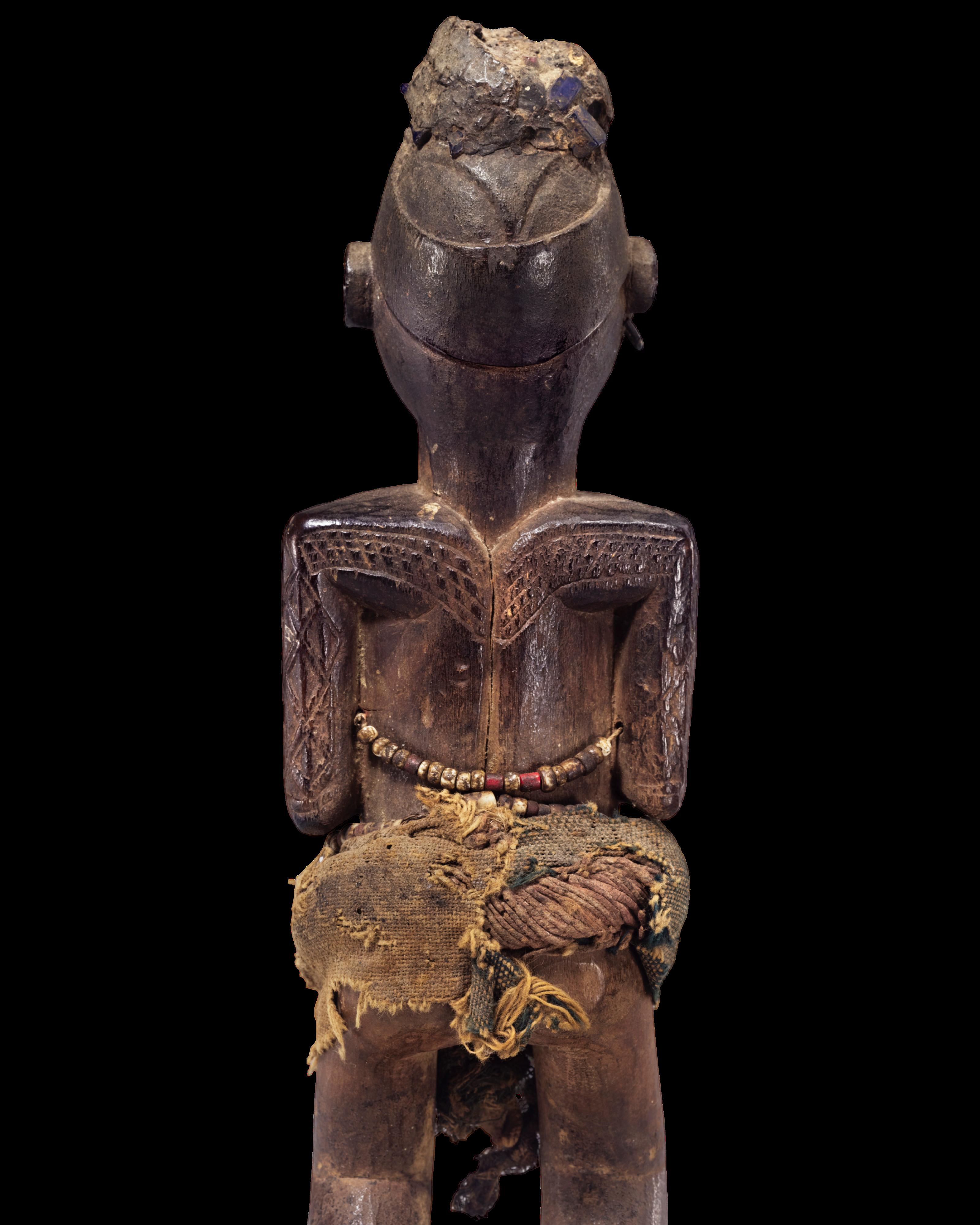










In the dimly lit halls of history, there exists a narrative woven with threads of resilience, wisdom, and grace a narrative that unfolds through the artistry of the classical African tradition. Within this rich tapestry, the feminine form emerges as a central motif, revered and celebrated for its profound symbolism and timeless beauty. Through their artistry, classical African sculptors sought to honor the divine feminine in all her manifestations, from the nurturing mother to the fierce warrior; from the wise elder to the playful maiden.
At the heart of FEMME lies a celebration of the sacred mysteries of womanhood the primal forces of creation and destruction, nurturing and protection, birth and rebirth. I invite you to create a picture in your mind. First we glimpse a mother, her arms outstretched in a gesture of love and nurturing. She embodies the essence of maternity, cradling her child with tenderness and devotion. In her eyes, we glimpse the wisdom of generations past, passed down through the oral traditions and ancestral rituals that define her cultural heritage. She is the keeper of stories, the guardian of traditions, and the embodiment of the timeless bond between mother and child. Beside her stands a healer, her hands adorned with beads and herbs, her gaze steady and focused. She channels the ancient wisdom of her ancestors, harnessing the power of nature and spirit to heal the body, mind, and soul. Through her rituals and remedies, she offers solace to those in need, bridging the gap between the physical and spiritual realms with her intuitive understanding of the human experience. In the background, a group of women gather in solidarity, their voices rising in song and celebration. They are the community builders, the pillars of support, and the catalysts for change within their communities. Through their collective efforts, they challenge injustice, uplift the marginalized, and foster a sense of belonging and empowerment among all who cross their path. On the periphery, a figure emerges from the shadows, her features obscured but her presence unmistakable. She is the ancestor, the guiding light, and the source of inspiration for future generations. Though her physical form may have faded into the mists of time, her legacy endures through the stories, songs, and traditions passed down from mother to daughter, from sister to sister, across the expanse of time and space. In the foreground, a young girl gazes into the distance; her eyes alight with hope and possibility. She is the future, the embodiment of dreams yet to be realized and potential yet to be unleashed. As she takes her place within the portrait, she carries with her the legacy of those who came before a legacy of strength, courage, and unyielding determination.
My hope in this show is to honor each woman from the above portrait. From the regal stature of a Luba-Zela kihona stool, to the intricate collaboration of an important Dan gunyege mask, each work serves as a testament to the intrinsic connection between women and the spiritual, social, and cosmological realms. In the Yoruba tradition of Nigeria, a rare female scepter of the god Eshu (normally presented as male) emerges as a potent symbol of maternal authority and spiritual prowess. Masterfully carved and with a deep patina from use, this scepter would have been wielded by devotees in ceremonies honoring Eshu, the divine trickster and messenger of the gods. Carved in exquisite detail and adorned with various bishimba, beads, and other accouterments of power, a superb nkisi figure from the Bwende culture of the Congo stands as both guardian and interpreter of the spiritual realm, its potent presence imbued with protective powers and maternal energy.
I am delighted to present this meticulously curated collection. Through a careful selection of thirteen works, each chosen for their rarity, quality and provenance, FEMME invites you on a transcendent journey across the African continent, offering a glimpse into the sacred realm of femininity. It is my hope that this collection will serve as a source of inspiration and empowerment, inviting viewers to embrace that divine feminine, not just within themselves but also within the world around them.
Welcome to FEMME a celebration of the feminine in classical African art.
COLE HARRELLMay 2024

Anthropomorphic Female Face Mask, NDOMA or MBLO
Unidentified Baule Artist, Cote d’Ivoire Wood, pigment
H: 33cm
PROVENANCE
Collection of Sylvie LeCamp, Paris, France, acquired circa 1960
Private Collection, Haute Savoie, France, thence by descent
Distinguished Private Collection, New York, acquired from the above Cole Harrell, New York
CF
The Barnes Foundation, Merion, Pennsylvania, inv. A189 (acquired from Paul Guillaume, 1922)
Royal Museum for Central Africa, Belgium, inv. EO.1969.59.1103 (acquired in situ by de Lehaie, 1933)
Coger-Dumont, Paris, 17 December 1981, lot 46 (acquired in situ by Pierre Loti, 1910)
Sotheby's, New York, 13 May 2011, lot 179 (collection of Pierre Matisse, acquired 1953)
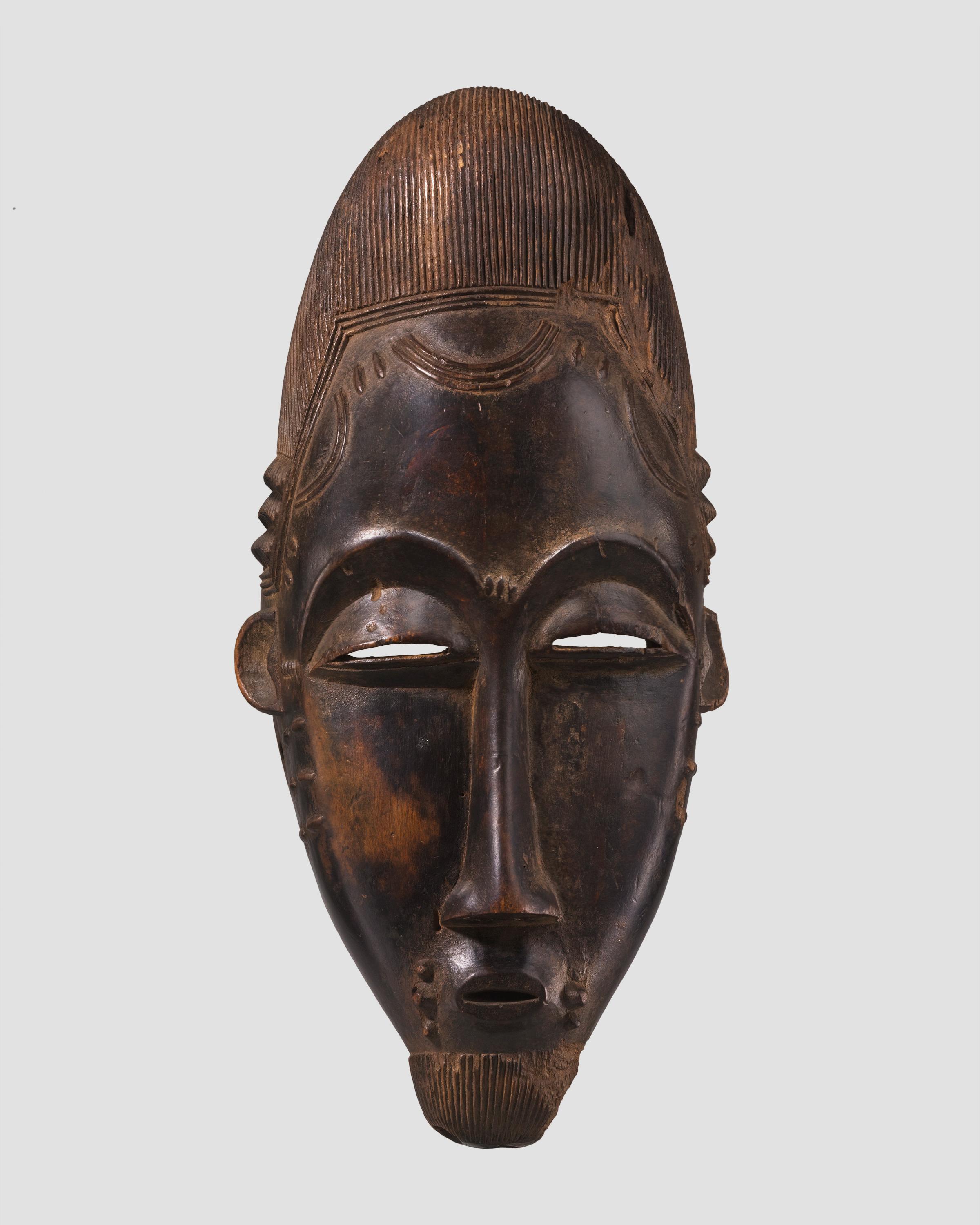
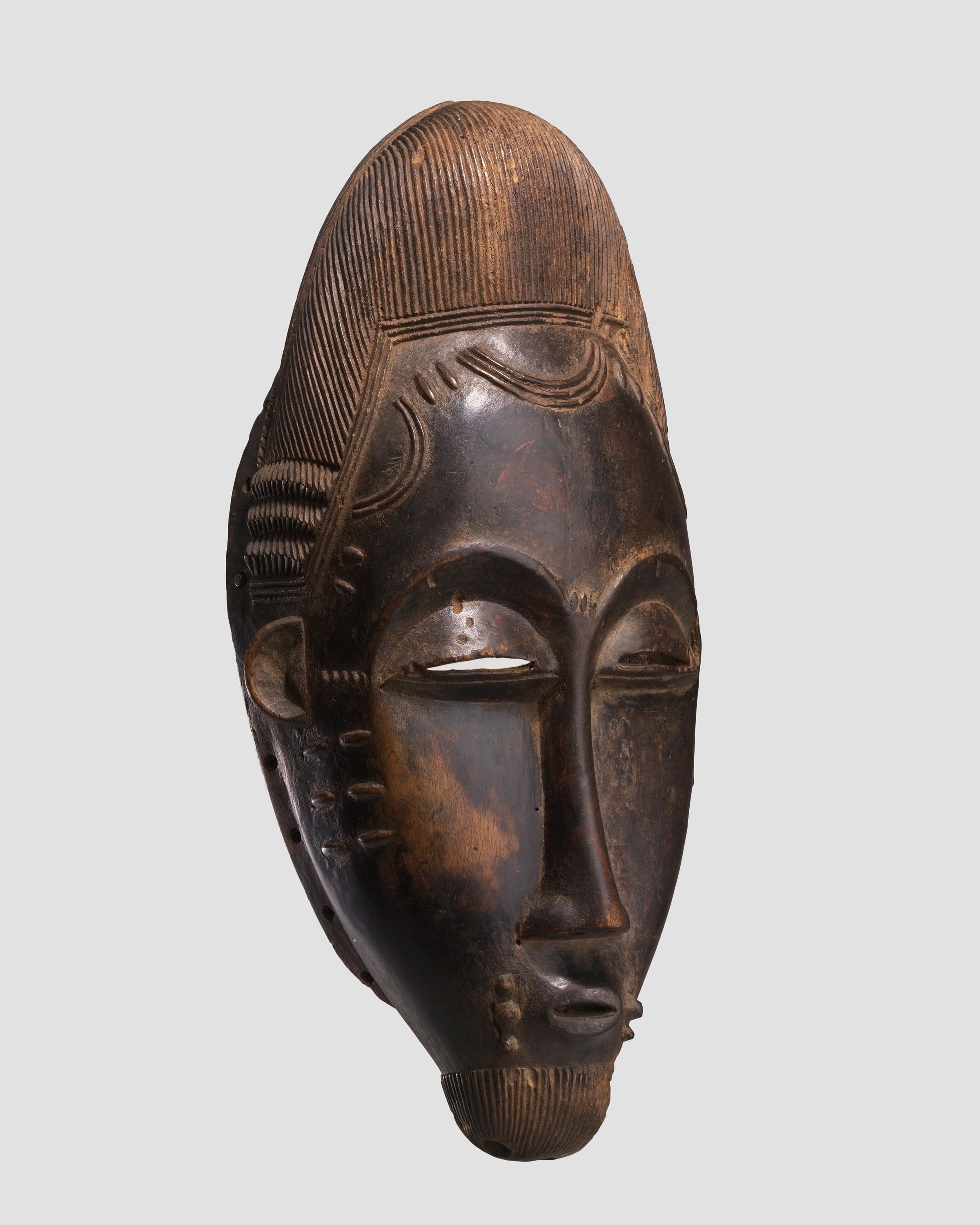
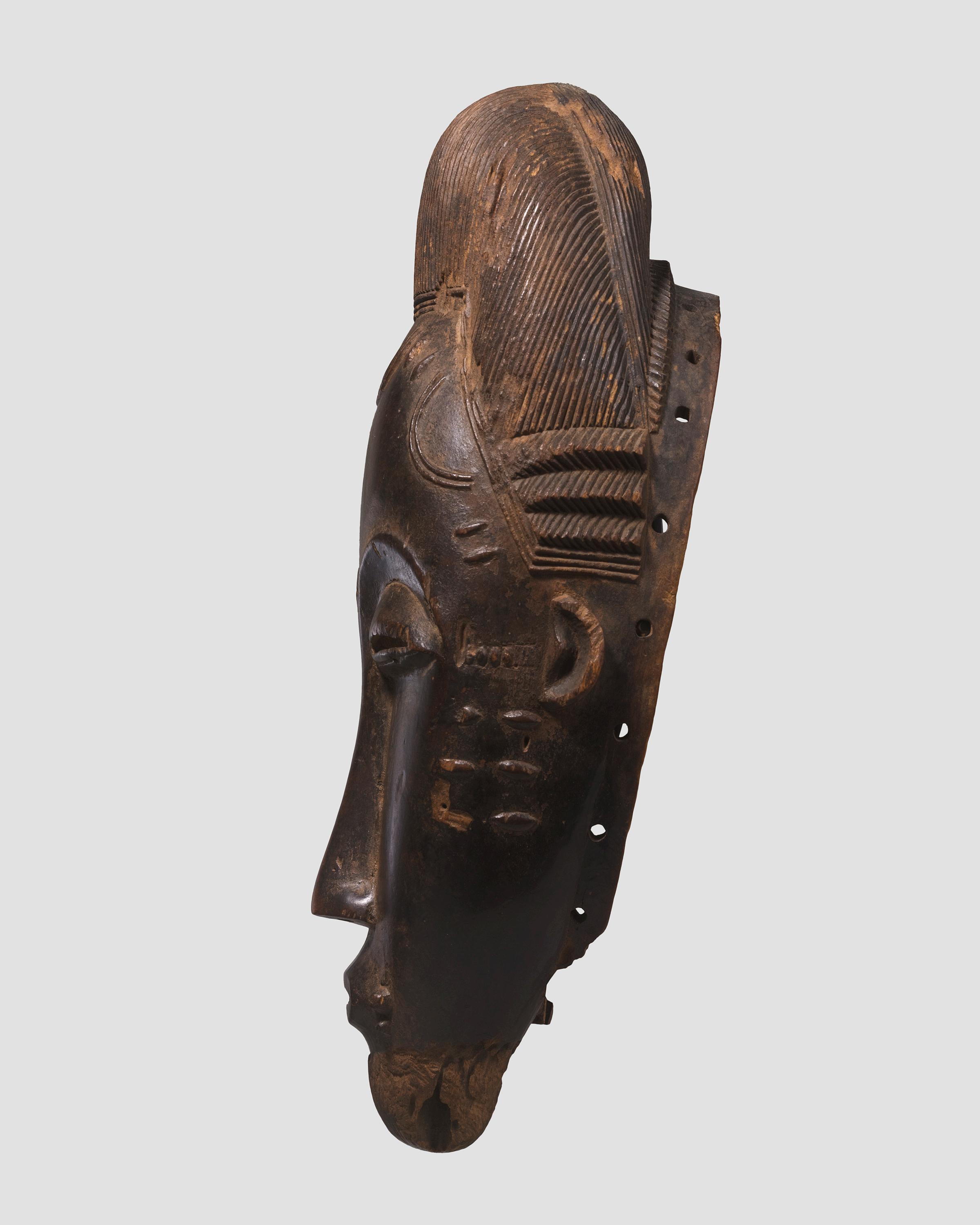
Anthropozoomorphic Female Face Mask, KPAN or GOU
Unidentified Baule or Guro Artist, Cote d’Ivoire
Wood, pigment
H: 33cm
PROVENANCE
Acquired in situ by Ambassador Gerald Scott (b. 1940) in Cote d’Ivoire, circa 1968 Collection of the Scott Family, Los Angeles, CA, circa 1968-2023
Private American Collection, acquired from the above, 2023 Cole Harrell, New York
CF
Gerbrands (Adrianus Alexander). Afrika. Kunst aus dem Schwarzen Erdteil" - 'Afrika. Kunst uit het zwarte werelddeel. Recklinghausen: Aurel Bongers, 1967#27
Expo cat: Traditionelle afrikanische Kunst. Dusseldorf: Galerie Alex Vomel, 1972
Expo cat.: Treasures from the Ivory Coast, New York: J.Camp Associates, Ltd, 1977:22, #41
Sotheby's. New York, African, Oceanic and Pre-Columbian Art, 18 November 2000, lot 83
Binoche & Giquello, Paris, Arts d'Afrique, d'Amérique et d'Océanie, 29 June 2021, lot 1

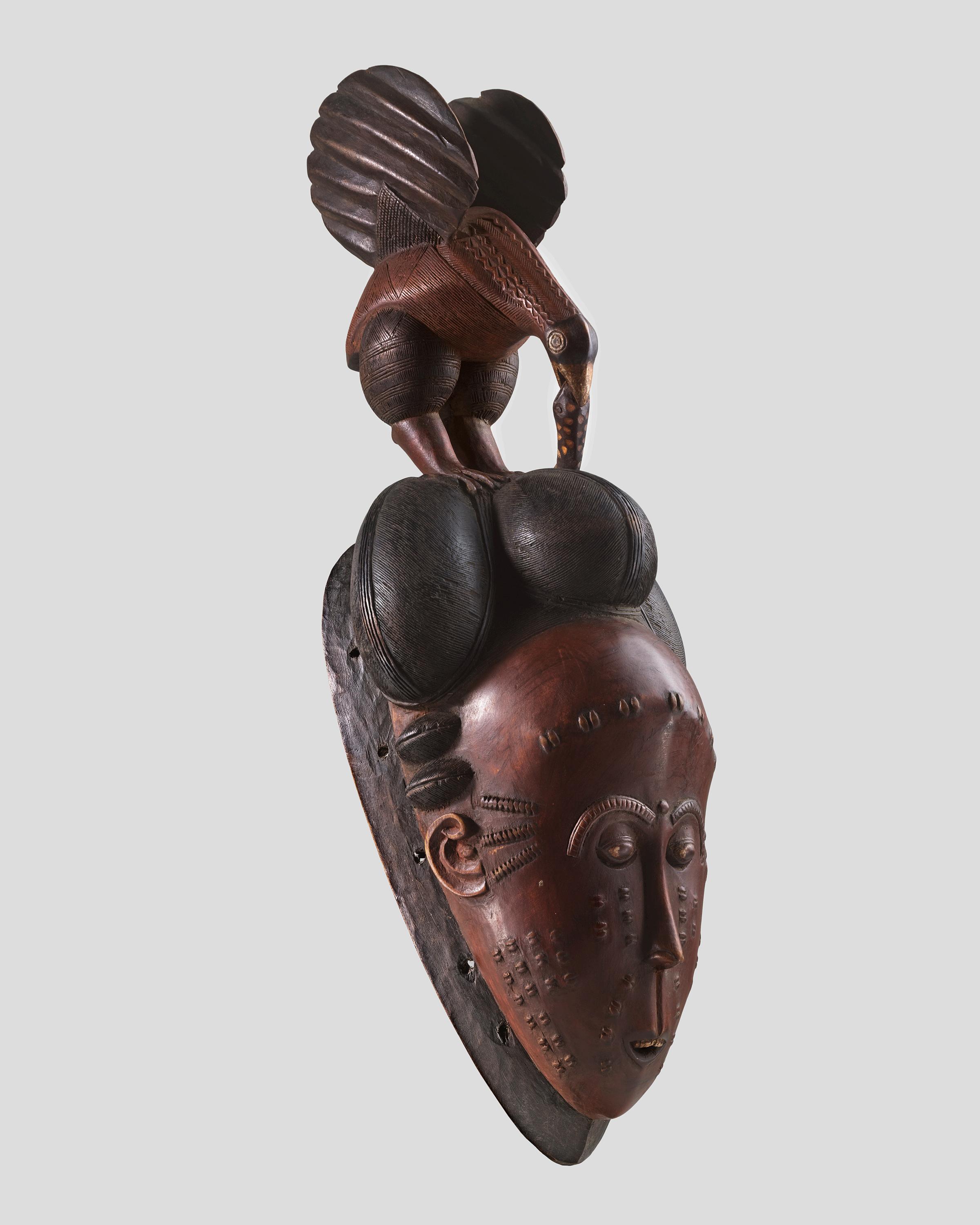
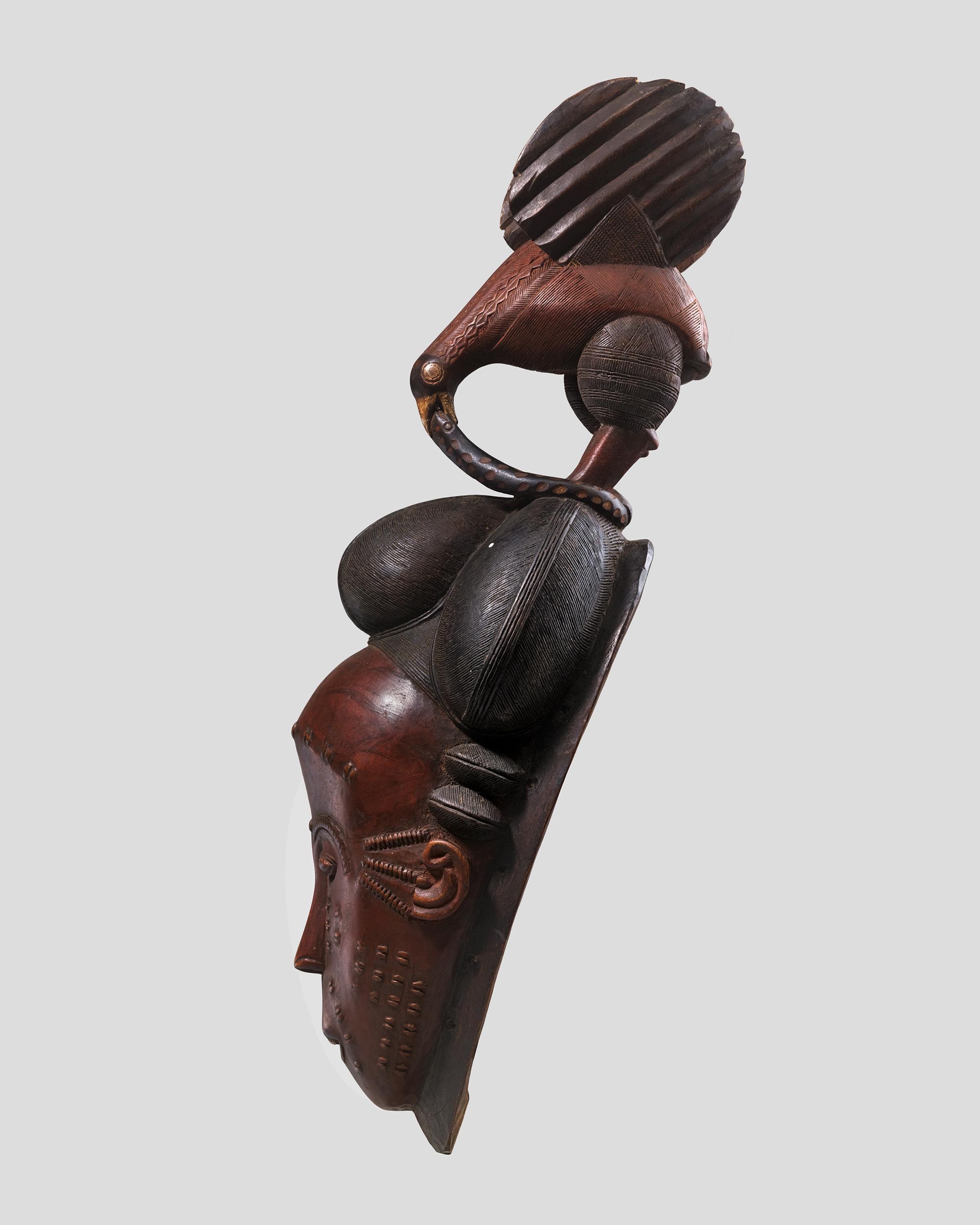
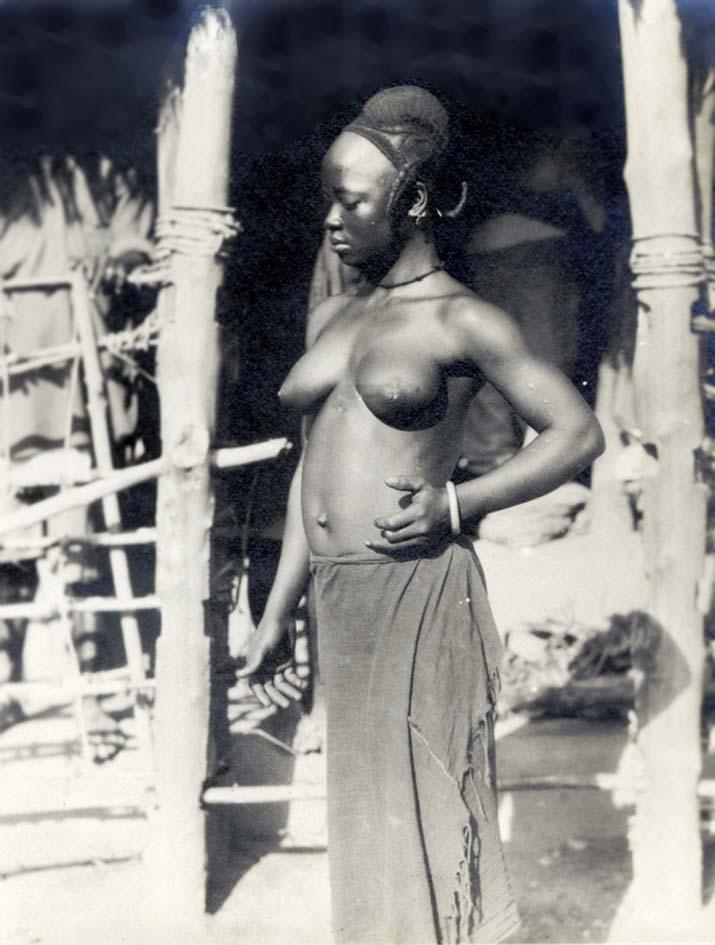
Anthropomorphic Female Face Mask and Coiffure, ZAKPEI or GUNYEGE
Identified Dan Artist, Liberia
Wood, plant fiber, cowrie (cyprea moneta), organic pigment
Height of the Mask: 25cm
PROVENANCE
Collection of Alfred L. Sheinberg (1949-1992), New York, by 1977
James Camp, J. Camp Associates Ltd, New York, acquired from the above, 1977
Collection of Dr. Robert Plant Armstrong (1919-1984), Dallas, TX
Christie’s, New York, The Robert Plant Armstrong Collection of African Art, 15 May 1985, lot 103
Collection of the Newark Museum of Art, Newark, New Jersey
De-accessioned to benefit the Newark Museum of Art, 2019
Cole Harrell, New York
EXHIBITED
New York, NY, USA: Treasures from the Ivory Coast, J. Camp Associates Ltd, 24 September-5 November 1977
LITERATURE
Cat: Treasures from the Ivory Coast, New York, J. Camp Associates, Ltd, 1977:29#81
“…this is a zakpai/zakpei fire mask or a gunyege runner mask. But read the comment by Marie-Noël Verger-Fèvre about a similar mask in the Barbier-Mueller collection (AHDRC 0137400): "The Barbier-Mueller Museum, Geneva, possesses a very similar mask, which has also retained its original, extremely ancient coiffure - a very rare feature in western collections. (Barbier, 1993, t. II, p. 60, inv. No. 1003-14). Writing about this mask, Marie-Noël Verger-Fèvre points out that although the round, latticed eye sockets generally denote gunyege racing masks and zapkei fire masks, the intricacy of the fibre postiche may well point to a much higher ranking figure - the "mask of the king" or go ge. It sometimes appears, in Dan country, alongside the leaders of lineage groups. It is a large mask that leaves the sacred dwelling only to announce the death of the 'king', or for other such serious matters. [...] Some are adorned with very intricate fibre postiches that mimic those of ancient warriors" (in Barbier, ibid.). (Source: AHDRC 0065919).”
- François Mottas, regarding the present mask, 12 May 2024
Preceding Overleaf
Mano woman in Que Congo, Liberia, by Loring Whitman, 1926
Photo courtesy A Liberian Journey: History, Memory, and the Making of a Nation
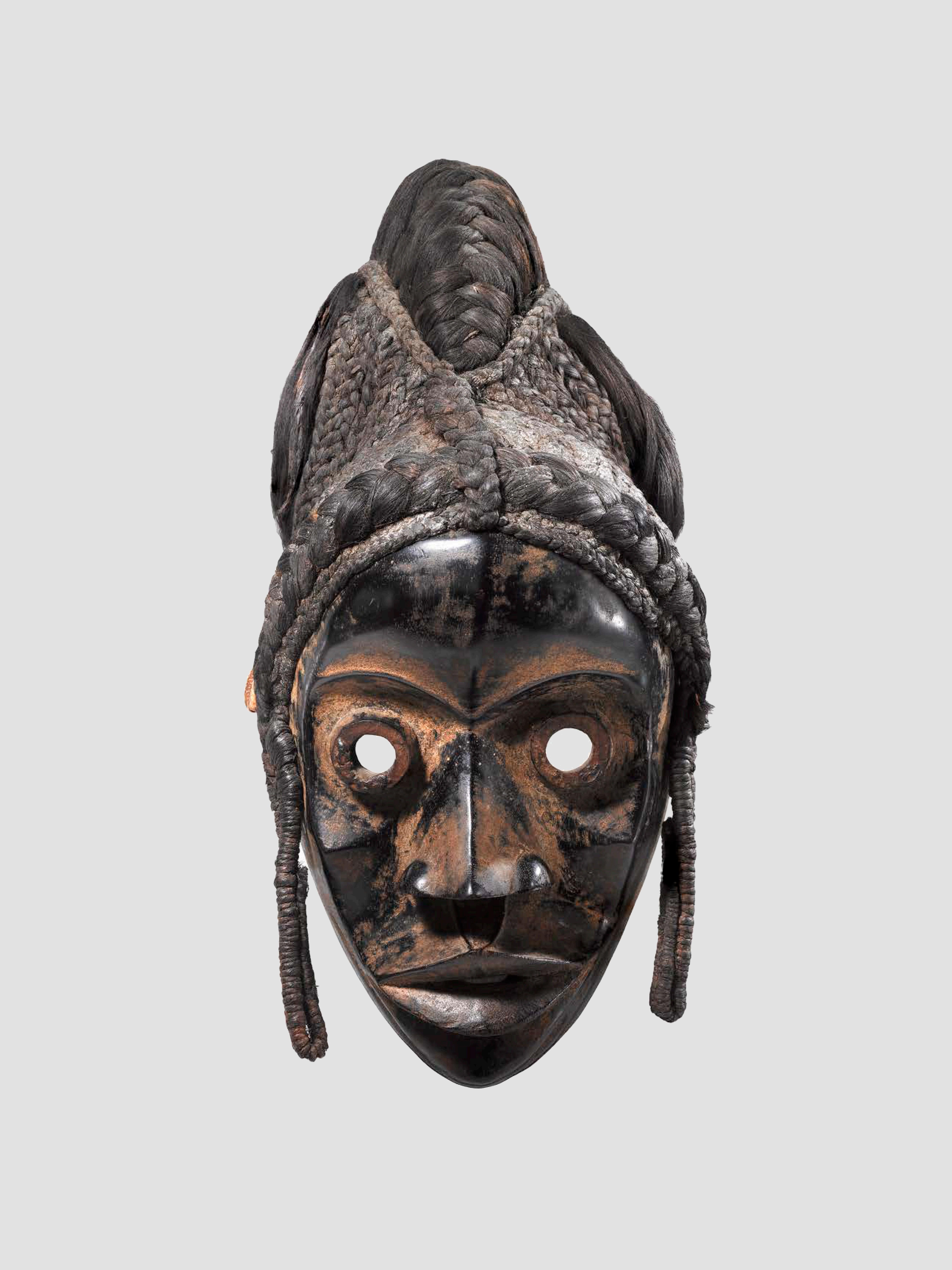

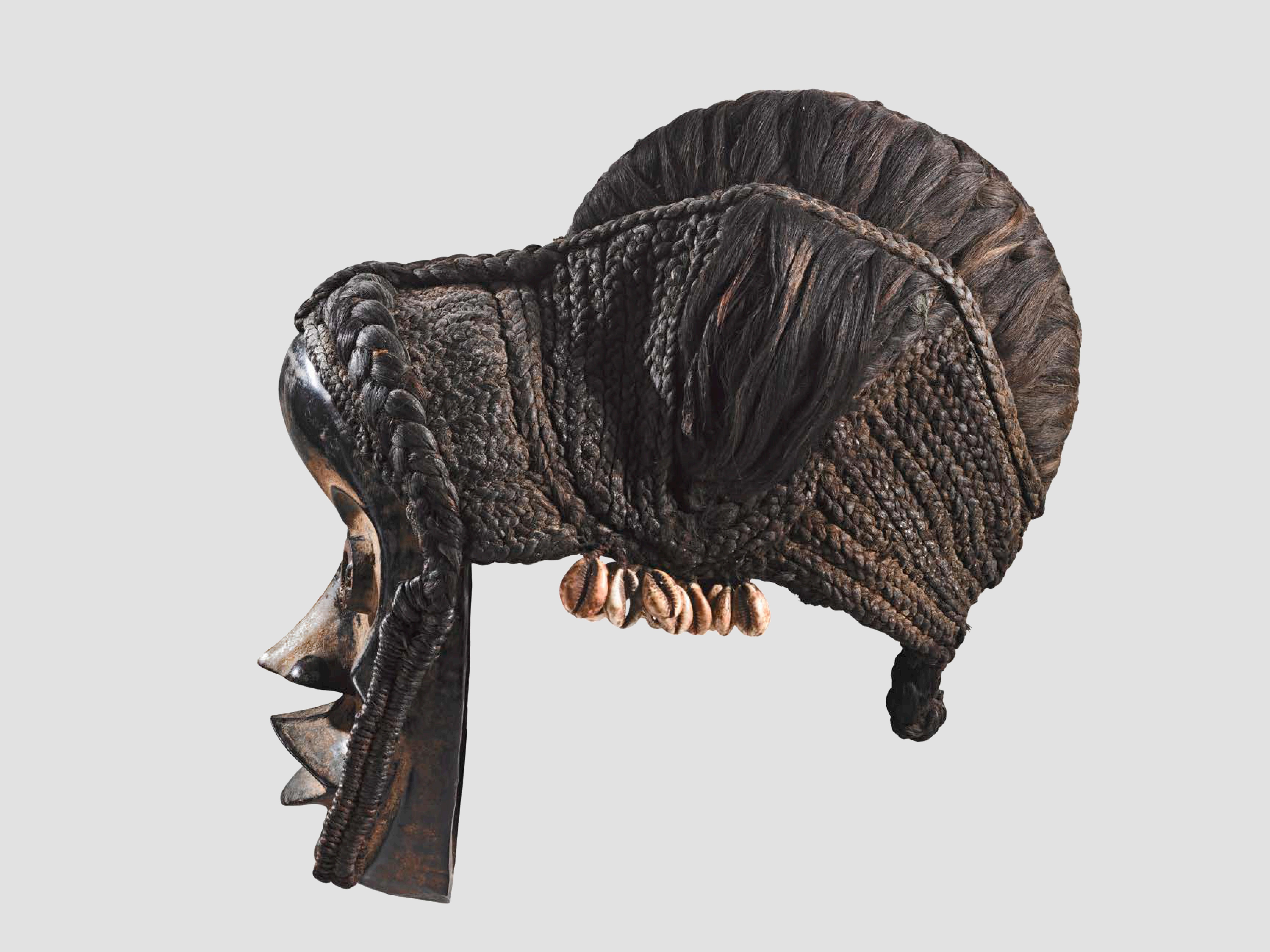


Anthropomorphic Female Face Mask, TANKAGLE or DEANGLE
Unidentified Dan-Yacouba Artist, Cote d’Ivoire
Wood, metal alloy, pigment, fiber, organic material H: 22cm
PROVENANCE
Merton D. Simpson (1928-2013), New York, NY, acquired 18 April 1964
Collection of William Brill (1918-2003), New York, NY, acquired from above before 1978, inv. 82 Private Collection, New York, NY, thence by descent, 2003
Sotheby's, New York, The William W. Brill Collection of African Art, 17 November 2006, lot 33 Lance Entwistle, London/Paris, UK/France, acquired at the above sale Cole Harrell, New York, acquired from the above, 2017 Beast Collection, Montréal, Canada, acquired from the above, 2017
LITERATURE
Lehuard (Raoul), La collection William Brill, in Arts d'Afrique Noire, no.26, Arnouville, 1978:22
Robbins (Warren M.) and Nooter (Nancy Ingram), African Art in American Collections, Survey 1989, Washington/London: Smithsonian Institution Press, 1989:160, #298 Robbins (Warren M.) and Nooter (Nancy Ingram), African Art in American Collections, Pennsylvania: Schiffer Publishing, 2004, #298
“I would classify your mask as a deangle mask, ‘gentle and graceful, representing an idealized Dan form of beauty’ (Johnson, p.7), which can be seen in the very subtle treatment of the eyelids and slit eyes, in the prominent cheekbones, and in the well-defined mouth contours including the groove of the philtrum. The engraved band around the face would have led Fischer and Himmelheber to classify it as a tankagle mask, but for me it would only as a sub-category of the deangle mask…”
- François Mottas, regarding the present mask, 12 May 2024
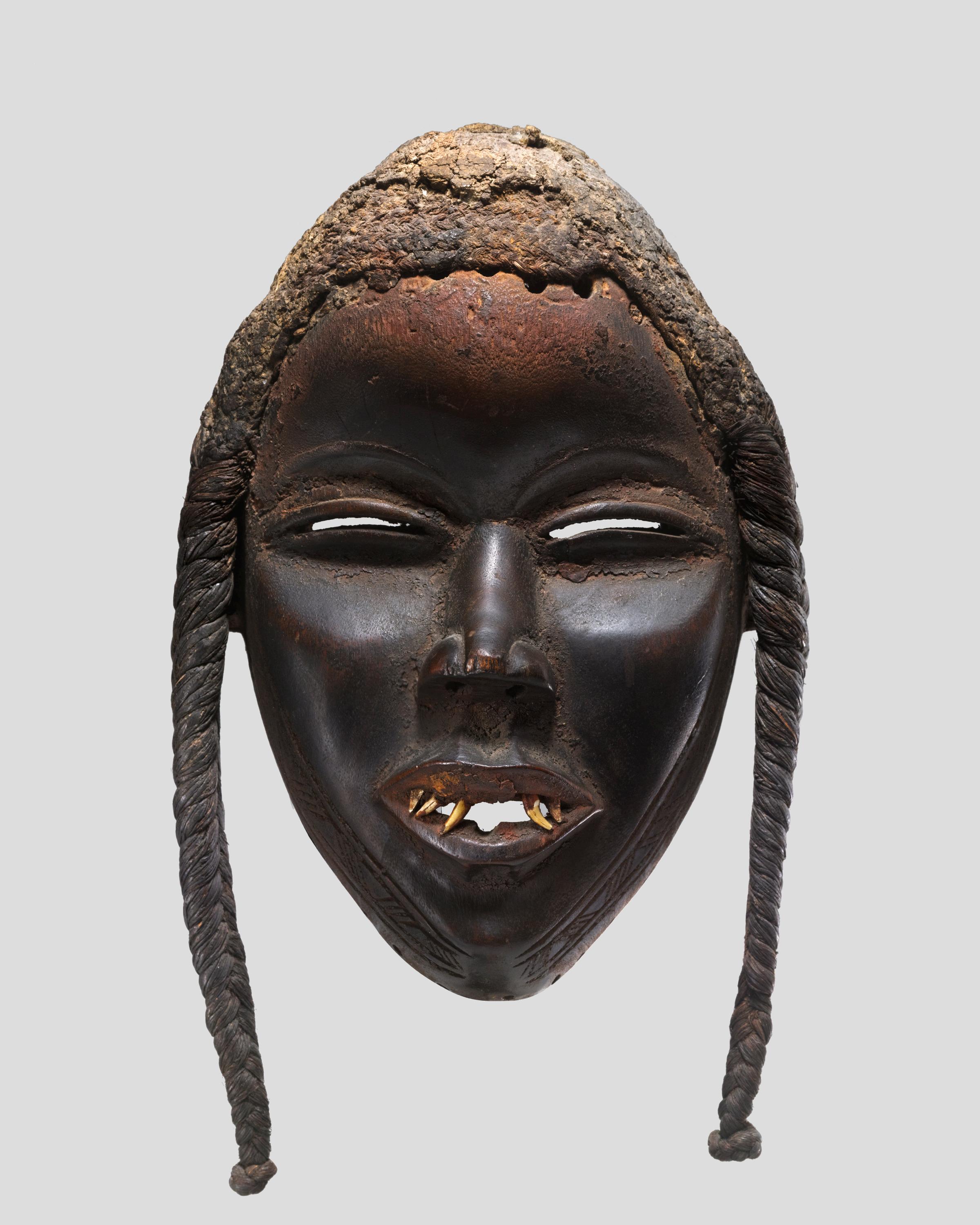
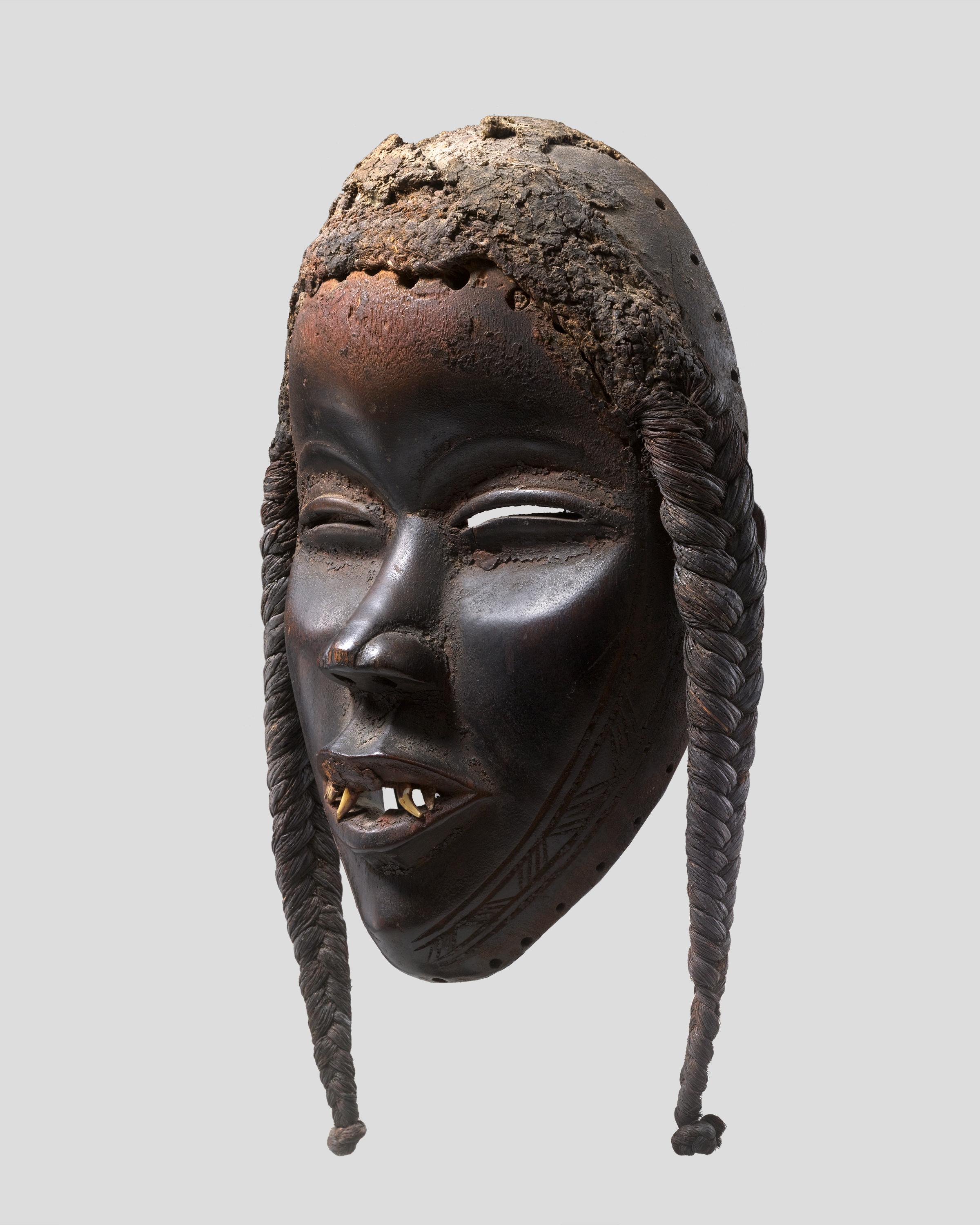
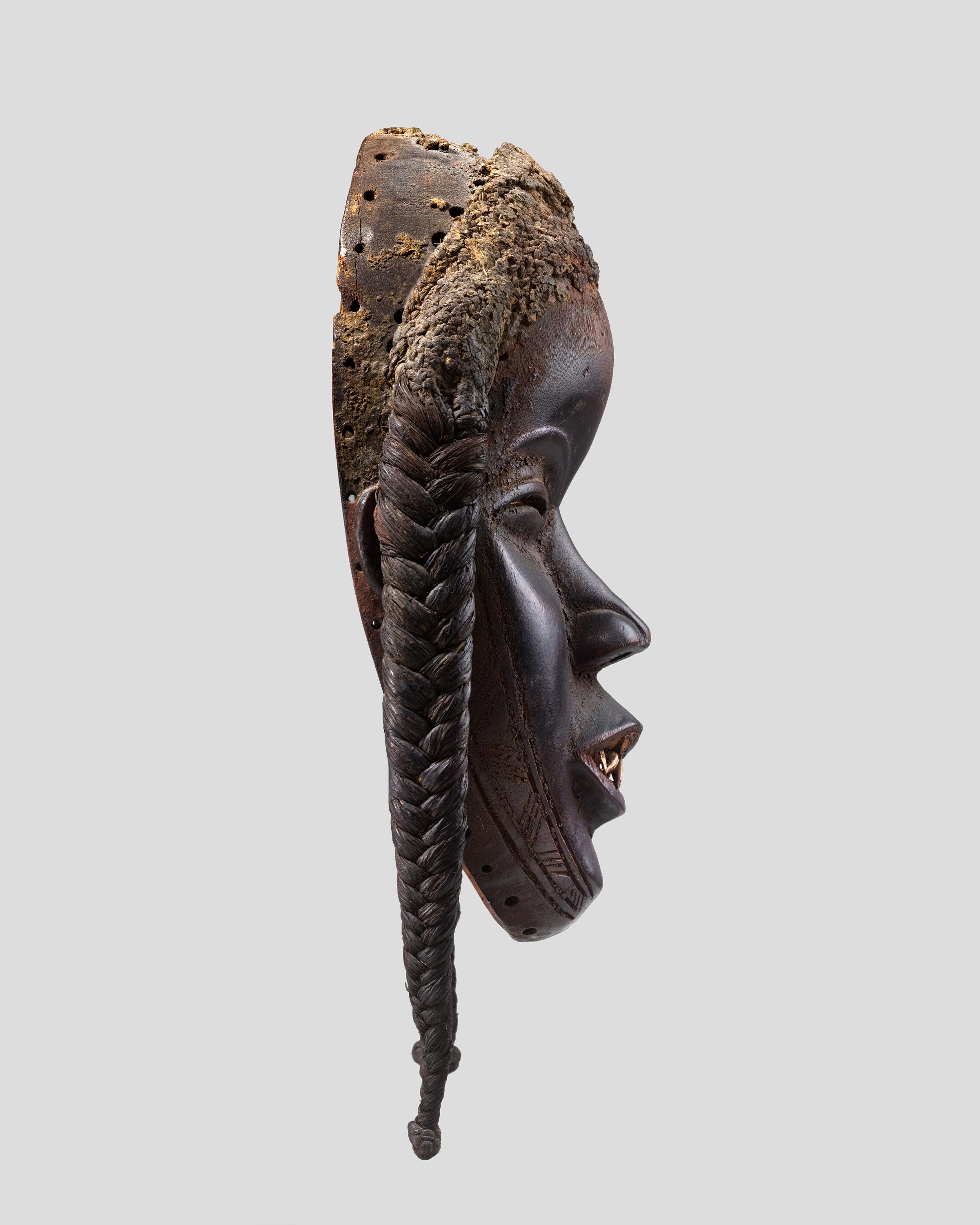
Anthropomorphic Female Face Mask, MFON EKPO
Unidentified Ibibio Artist, South East Nigeria
Wood, alloy, pigment
H: 58cm
PROVENANCE
Collection of Hendrick “Rick” Elias (1925-2014), Weize, Belgium
Galerie Elmar, Weize, Belgium
Collection of Lionel Morley (b. 1941), Spain, acquired from the above
Jo de Buck, Brussels, acquired from the above, 2009
Collection of Jean and Noble Endicott, New York, acquired from the above, 2009
Amyas Naegele, New York, NY, acquired from the above
Cole Harrell, New York
CF
Christie's, London, Sale of The Meulendijk Collection of Tribal Art, 22 October 1980, lot 105
Loudmer, Paris, Arts Primitifs, 8 December 1985, lot 138 (collection of L. Van de Velde, Antwerp)
AHDRC Archive no. 0092277 (collection of Vittorio Mangio, Italy)
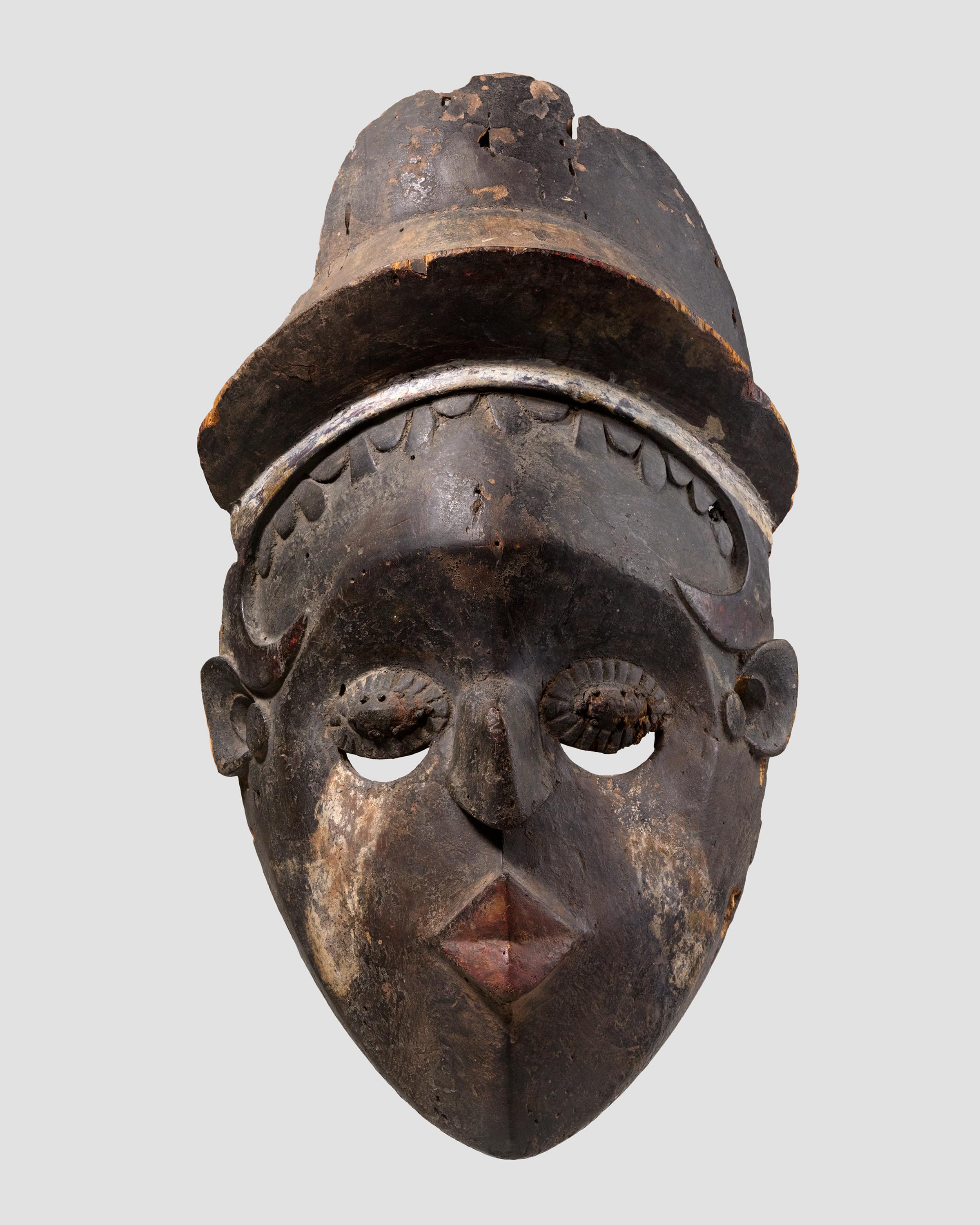


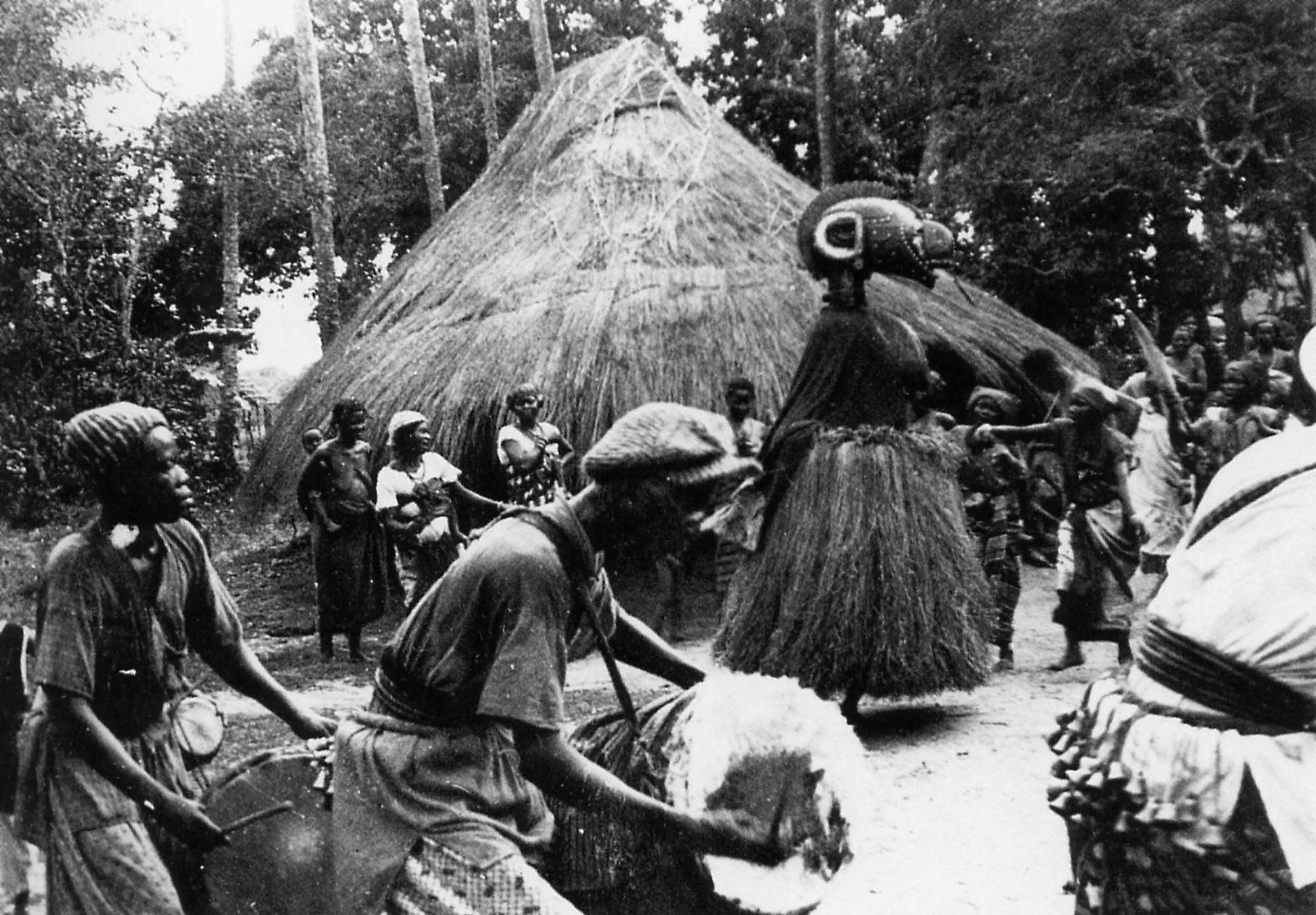

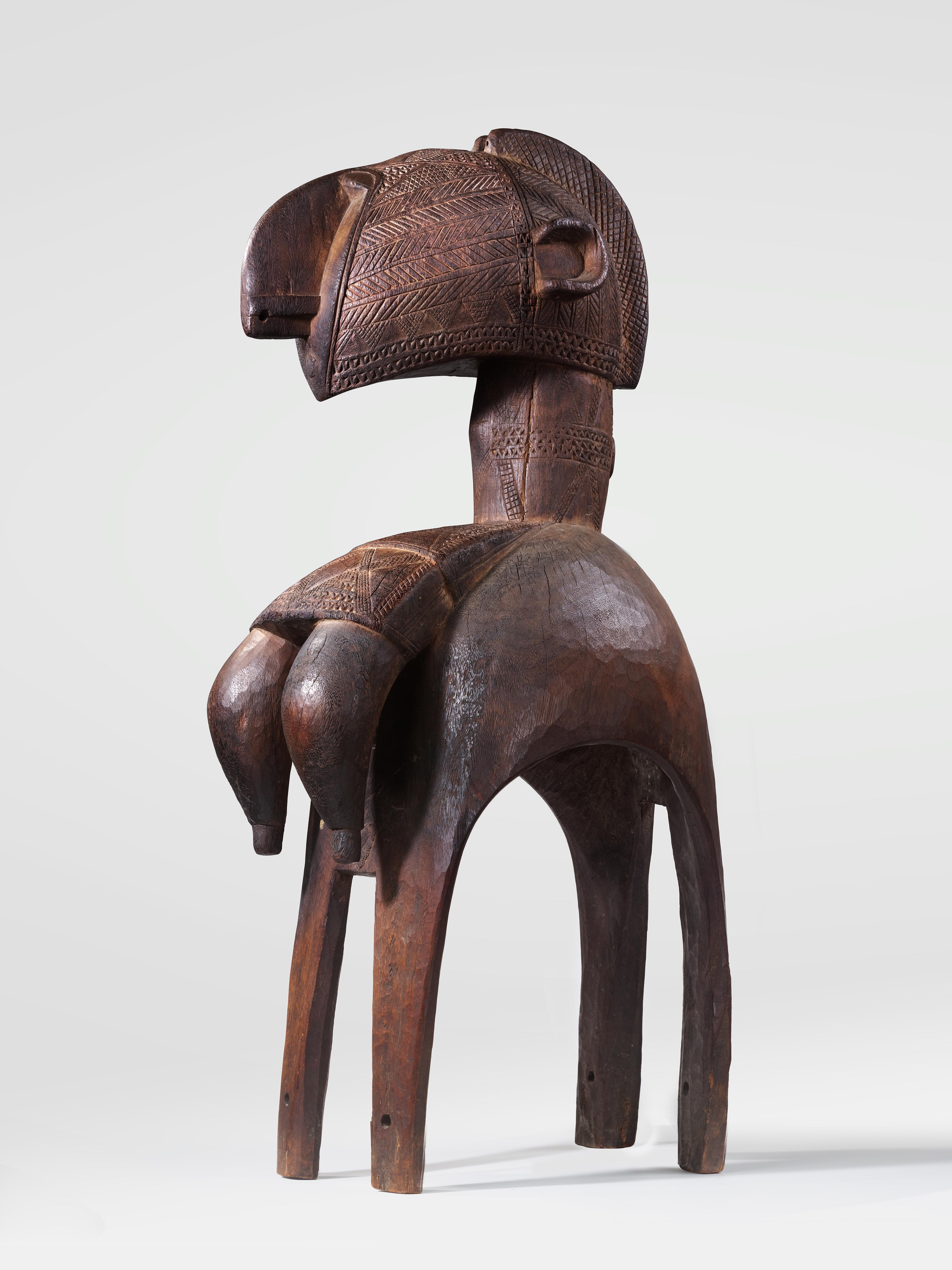
Anthropomorphic Female Headdress, D’MBA YAMBAN
Identified Baga Artist, Guinea Wood, organic pigment H: 104cm
PROVENANCE
Almost certainly acquired in situ by Emil Storrer (1917-1989), Zurich, circa 1950
Almost certainly Julius Carlebach, New York
Private Collection, Detroit, Michigan, acquired circa 1970
Private Collection, Michigan, thence by descent
Cole Harrell, New York
CF
Fine Arts Museum of San Francisco, San Francisco, CA, inv. 2008.38.17 (gift of the Erle Loran Family Collection) Kreeger Museum, Washington, D.C. (acquired from Julius Carlebach, 1968; acquired in situ by E. Storrer, 1952) Museum Rietberg, Zürich, Switzerland, inv. RAF 7 (acquired in situ by Emil Storrer, 1952)
Preceding Overleaf
Masquerade, dance of Nimba by Beatrice Appia
Photo courtesy The African Heritage Documentation & Research Center, Brussels
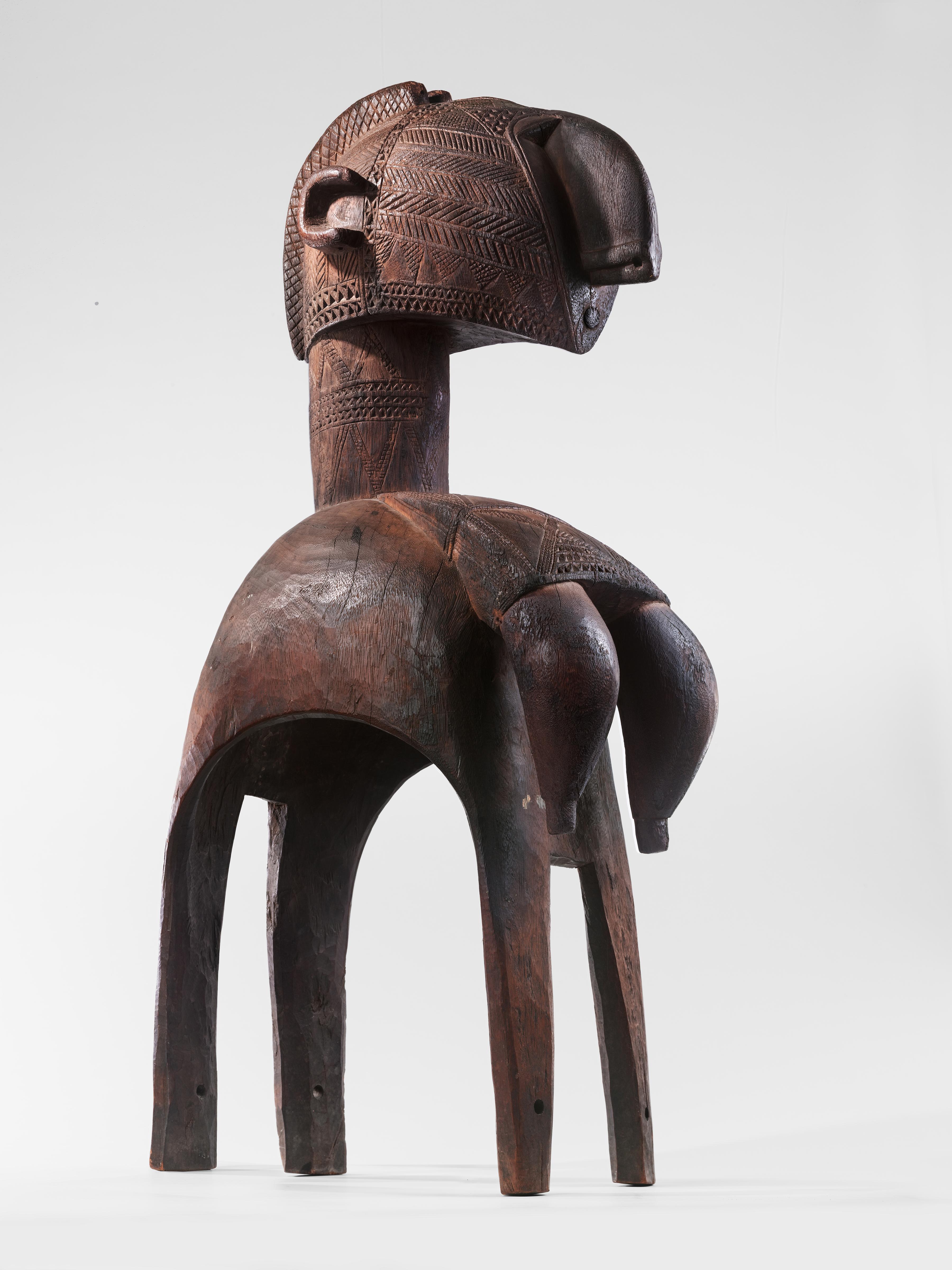
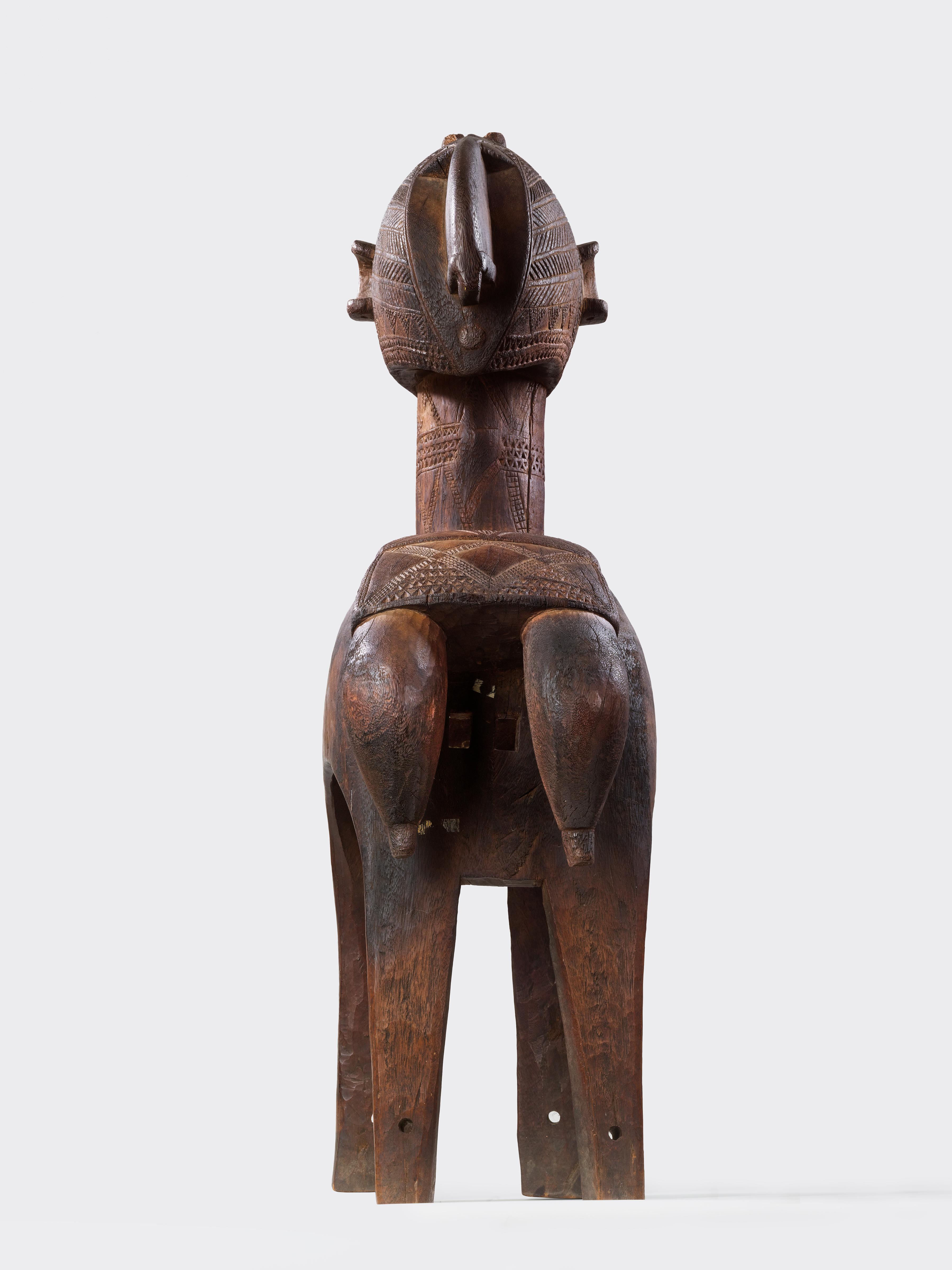
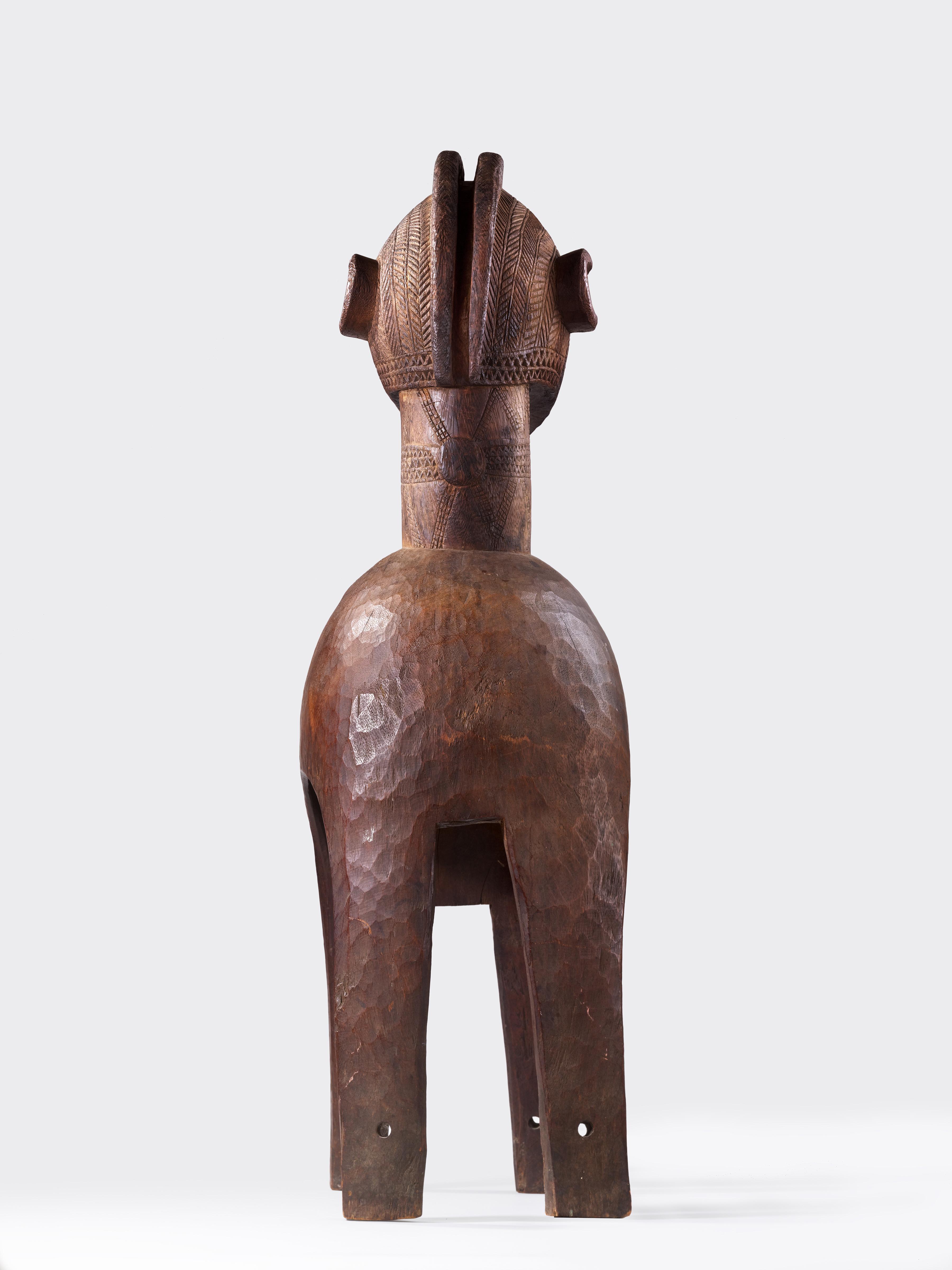
As famous, emblematic, iconic as it is rare, the Nimba mask, thus named by foreigners, D'mba by the Baga Sitemu, and Yamban by the Pukur (Izart, 1935: 22), can be literally transliterated as the "good spirit". The narrow corpus summarized by Frédéric Lamp (Art of the Baga, 1996, p. 155-179) forms only fifteen copies, thus cementing the sculptural language, and serving as a testament to the strength of belief of the Baga people, their resilience and their ability to reinvent their art and society.
Discovered very early, mentioned for the first time in Manuel Alvares’s manuscript suggesting the existence of a D'mba entity around 1615, then documented by Nordeck in 1886, the first Nimba collected was by Lieutenant Brocard in the village of Tshalbonto, now preserved at the Quai Branly Museum, Paris, France. Later, in 1960, Hans Himmelheber, in his seminal work Negerkunst und Negerkünstle, approaches Baga statuary based on photographs provided by the Zurich collector and dealer Emil Storrer (1917-1989). From Storrer the most emblematic Nimba examples were brought back, including two additionals probably made by the same hand as the work in question. One of which is exhibited at the Kreeger Museum in Washington, and the second at the Rietberg Museum in Zürich. Much has been written about Nimba masks and their relationship to early Modernism. Between their monumentality, their symbolic power and their bold new stylistic presentation, Nimba masks famously inspired some of the greatest artists of the Modernist movement. Picasso acquired his Nimba in 1920 it had such an influence on him that according to some art historians, the portraits and plastered heads of Marie-Thérèse Walter, with her projected aquiline nose, were directly inspired by that of his Nimba These portraits showcased Picasso’s innovative ingenuity and desire to distance himself from realistic natural forms to achieve pushed abstraction by means of schematized shapes and geometric decorations (Van Geentruyen 1979, p.23).
Driven from their original lands of Fouta Djallon, forced into exile from the 15th to the 18th century due to Islamized Fulani invasions, the Baga settled in scattered groups in the north of the Guinea coast. The Baga oral tradition, recounts their arrival on the coast of Guinea, their need to establish, reconstitute their policies, laws and their society. In this process of reinvention, going hand in hand with the appropriation of new lands, it appeared fundamental and essential to recreate an artistic form representing the quintessence of women: idealized beauty, a founding icon, a guardian and protective image and symbol of the nurturing mother images with whom they sought refuge for the fruitfulness and for the fertility of the earth. According to the Temne people, “the world was created by the spirit of the woman, she is the origin of life” (Lamp, 1982, p.244-283). Thus, wearing the mask was synonymous with carrying life, to the point that when giving birth, according to Sayers (1927: 111) women would say "I po’ sara a-ron," which literally translates to "I have carried the mask on my head." Initially, according to the testimonies of the Pukur, corroborated by the consultants of Sitemu, the Nimba mask was singular and sacred; it was kept in a place especially dedicated to it, where it received sacrifices. Later on, the original Nimba was reproduced and used for various ceremonies. The dancer of the sacred mask (Elder, Christian, Era, Pukur, 1986) performed a rhythmic, dynamic dance with "calm and vigorous steps at the same time, sometimes swirling and delicate." (Lamp, 1982). The dance was accompanied by jerky rhythms, drums called sëngbe, sanda castanets, and songs.
The corpus of Nimba masks obey simple geometric canons composed of curves (heads and bust), separated from cylindrical shapes (neck and support). According to Mnar sculptor Sama Camara, Nimba masks “are inspired by human beings and at the same time evoke animal figures” (Mnar interview 2008). The head, with its full stretched volume, takes on the appearance of a half-circle; the large curved, hooked nose is, according to Marie-Yvonne Curtis, a reference to the hornbill bird, to fertility (Visions d'Afrique, Baga, 2018). The present example’s bell-form bust is announced by a subtle engraved decoration whose diamond could signify an adornment, a necklace that elegantly lies upon and enhances a
plunging chest. The breasts are rendered round and generous, in contrast to the more classic iconography of flattened breasts. Symbolizing fertility, intensity, and power, the round swollen breasts are as if full of milk. Her firm posture is reinforced by her stature, both static and dynamic. Her head is proud, facing forward and held up by her thick neck. The profile of her slightly arched chin, whose shape is subtly echoed by her crested, striated headdress, feels resolutely inventive, pushing towards abstraction, reinventing physical proportions through geometric volumes
African sculptures often borrow symbolic codes rooted in and referencing their ethnic identity. Among the Baga, this "norm" is not a rule, and we are faced with an exceptional aesthetic aspect, a confirmed curiosity; some of the attributes and ornaments characteristic of the Nimba do not correspond at all to those of Baga women from the past, but rather to those of women from other ethnic groups, more specifically the Fulbe women. By analyzing the photographic documentation from the first half of the 20th century, outside the Baga territory (photographic archives of the Fathers of the Holy Spirit, 1930 and Corrêa, 1943: 371), a remarkable and undeniable similarity appears between the hairstyles of the Fulbe women from Fouta Djallon, those of women from Sierra Leone, and the hairstyle of the Nimba. All of them are composed of a crest split in two, one at the top of the skull, the other plunging towards the front of the forehead, both reinforced by braided tresses. These sophisticated headdresses, sometimes adorned with long extensions extending along the face, could have been represented by the facial scarifications of the Nimba According to Lamp, the double marks on the cheeks indicate a belonging to the Baga ethnic group, referencing the identity of the ancestor who gave birth to generations of Baga children, spiritually and physically nurturing them. Idolized and adored, when she emerged for ceremonial procession, men and women came to pay homage to her, and often in a customary gesture, their hands rested on their chests, affirming their fertility, imploring and showing respect for the nurturing power. This act, this gesture, also endowed the dancer with powerful fertility (Boris Kegel Konietzko, personal communication, 1958). The adoption of the Fulbe aesthetic style in the Nimba statuary, beautifully displayed in this remarkable work, can be considered as an acceptance, a recognition, a distinctive sign of belonging to the conventions of the most privileged status in society. This confirms the prestige of the Nimba as an unattainable tutelary entity, tending towards perfection, an object of desire, beauty, and adoration. Her elaborate, structured hairstyle, the richness of her ornamentation with fine engraved and incised decorations, magnify her beauty and reinforce her inaccessibility.
However, her goodness, her generosity (enhanced by her full volumes and curves), expresses an ideal of Baga beauty. By exuding fertility, she symbolically ensures the survival of the community. With her strength and feminine power, she is associated with abundant harvests and sustainability. To fulfill these wishes, a spiritual entity was invoked in the sacred hut by the lineage chief who performed the customary sacrifices and offerings. Later associated with agricultural rites linked to the prosperity of the soil, she was taken out and danced from May in the sacred places of the village and along the rice fields to bless the land. She is the Mother of mothers in all her splendor and beauty.
Anthropomorphic Female Face Mask, OKUYI
Unidentified Punu Artist, Gabon
Wood, kaolin, pigment, raffia
Height not including raffia: 30cm
PROVENANCE
Private Collection, New York
Cole Harrell, New York
CF
Arts d'Afrique Noire, no.43, 1982:32 (acquired in situ Father René Guyader in Gabon between 1897-1925)
Perrois (Louis) & Grand-Dufay (Charlotte), Punu, Milan: 5 Continents Editions, 2008: #7 (collection of the Abbey of Mortain, France, by 1931)
Christie's, Paris, Art Africain et Océanien, 15 June 2010, lot 67
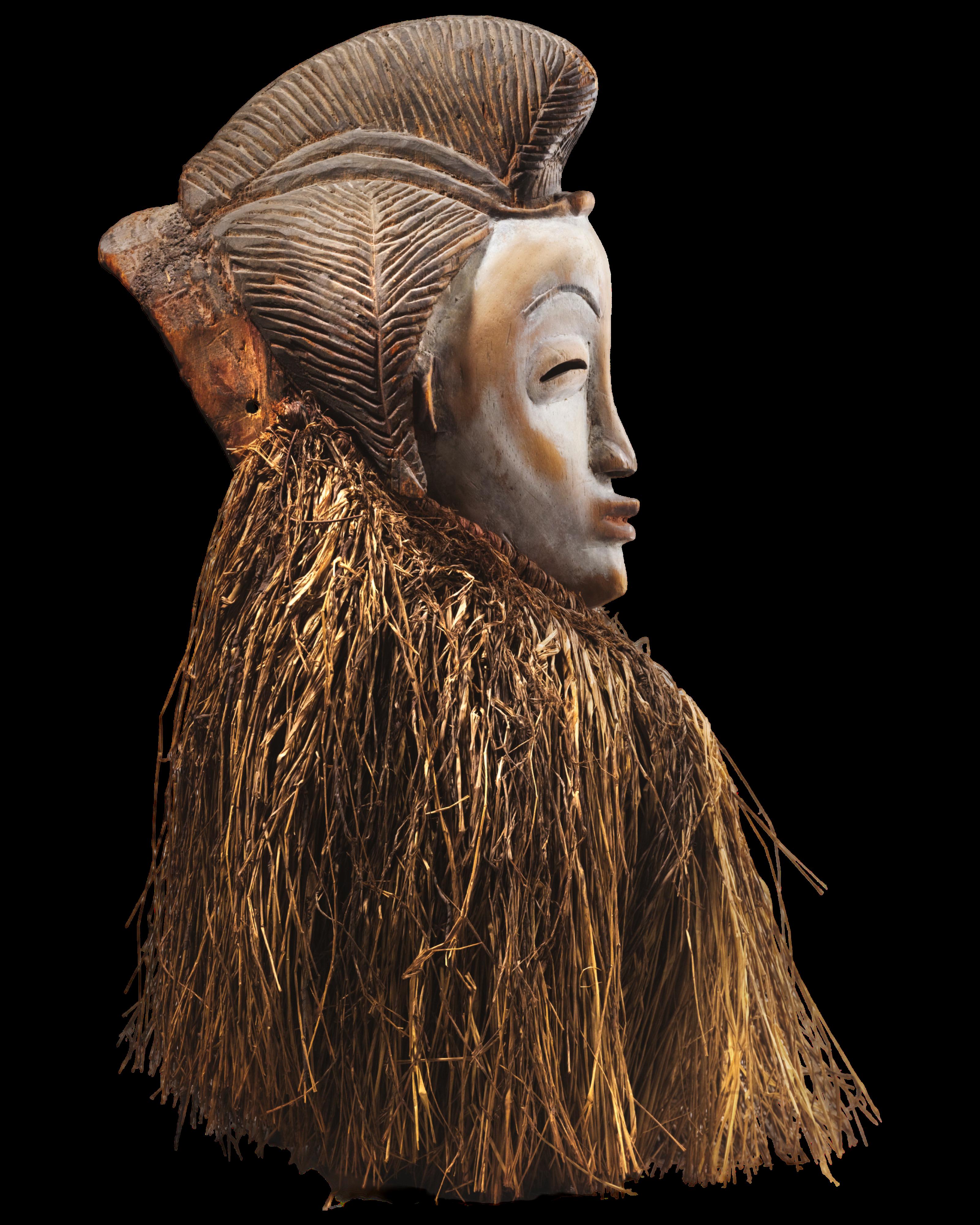
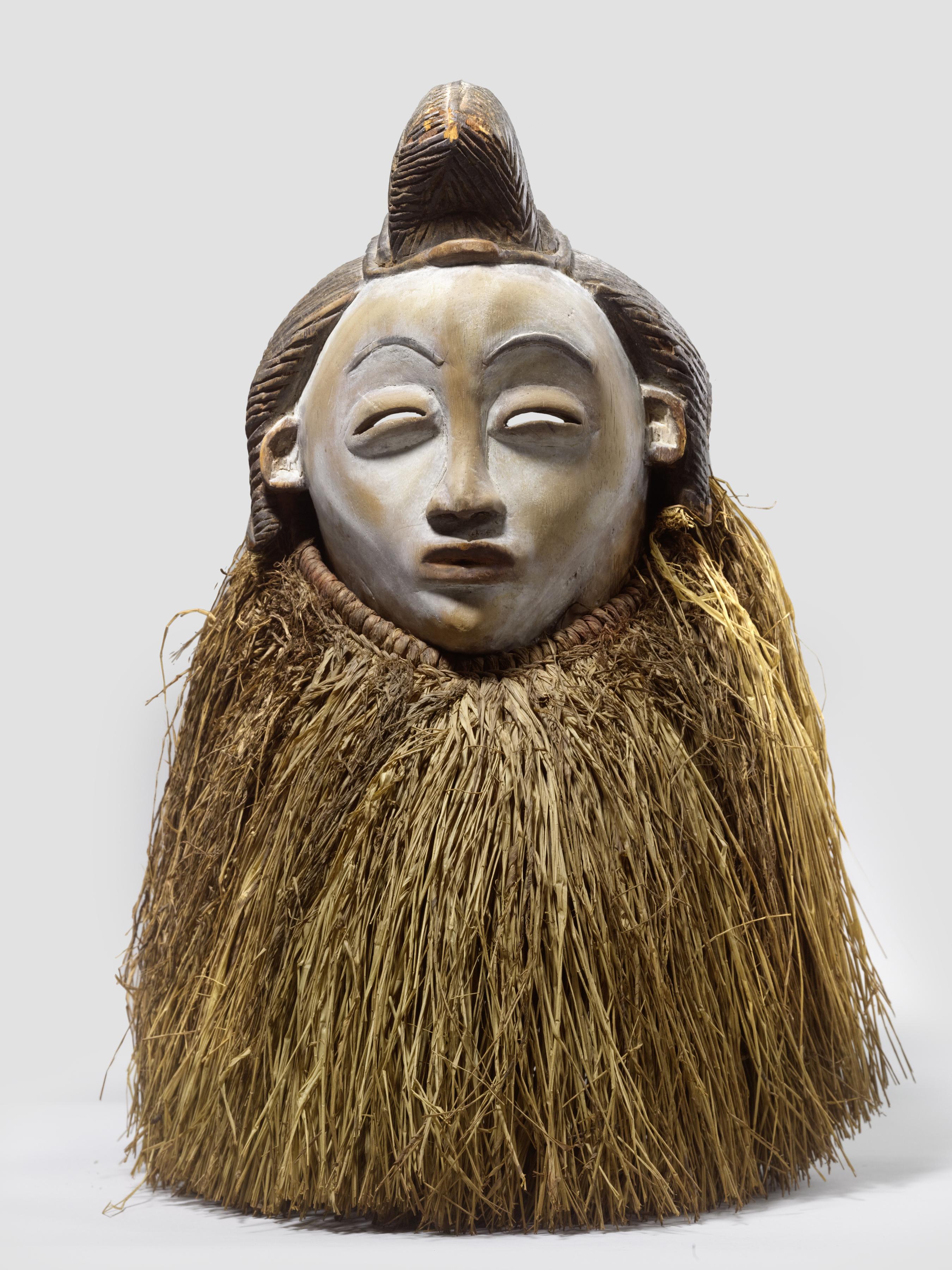

Anthropomorphic Maternity Ensemble
Unidentified Turka or Gouin Artist, Burkina Faso Wood, natural pigment
H: 42cm
PROVENANCE
Private American Collection, acquired circa 1970
Distinguished Private Collection, Brussels, acquired from the above Cole Harrell, New York
CF
Kjersmeier (Carl), Centres de style de la sculpture nègre africaine, Paris, Editions Albert Morancé/Kopenhagen, Fischers Forlag, Vol.1, 1935: plate 32 (acquired in situ by Carl Kjersmeier in Bobo Dioulasso, 1932)
Metropolitan Museum of Art, New York, inv. 1984.521.3 (gift of Mr. and Mrs. Bernard Leyden, 1984)
Sotheby's, Paris, Collection Nicole and John Dintenfass, Art African, 23 June 2006, lot 32
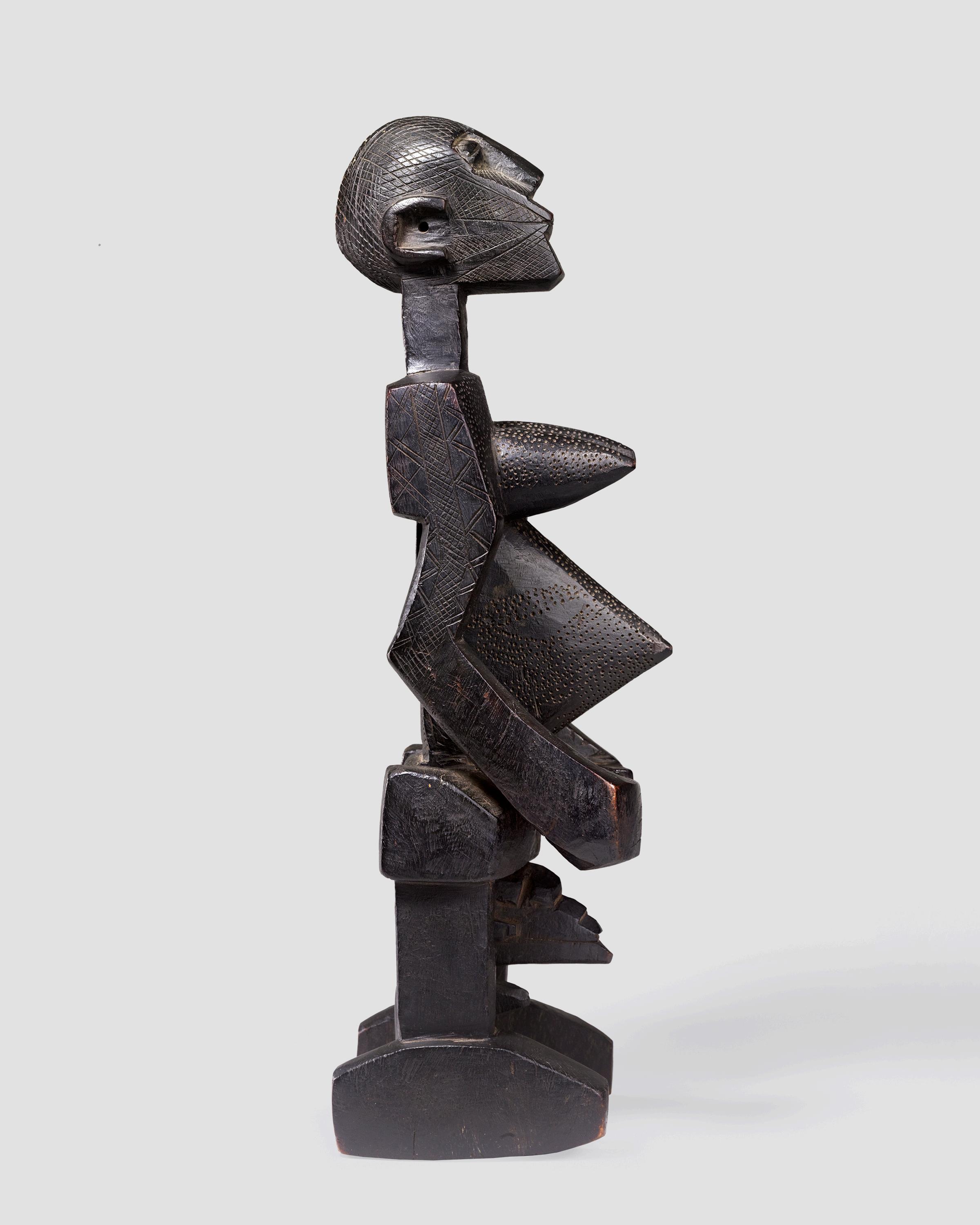
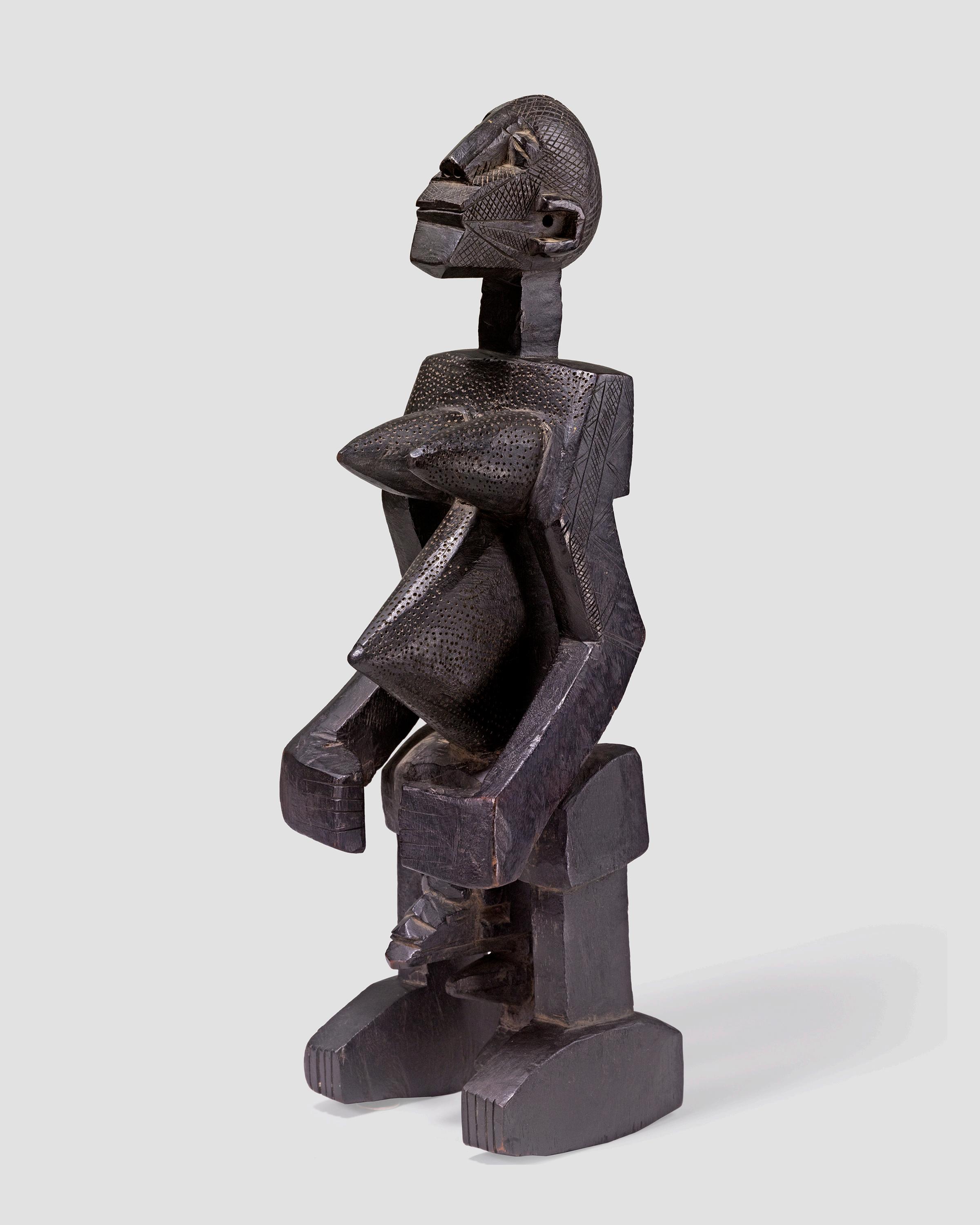
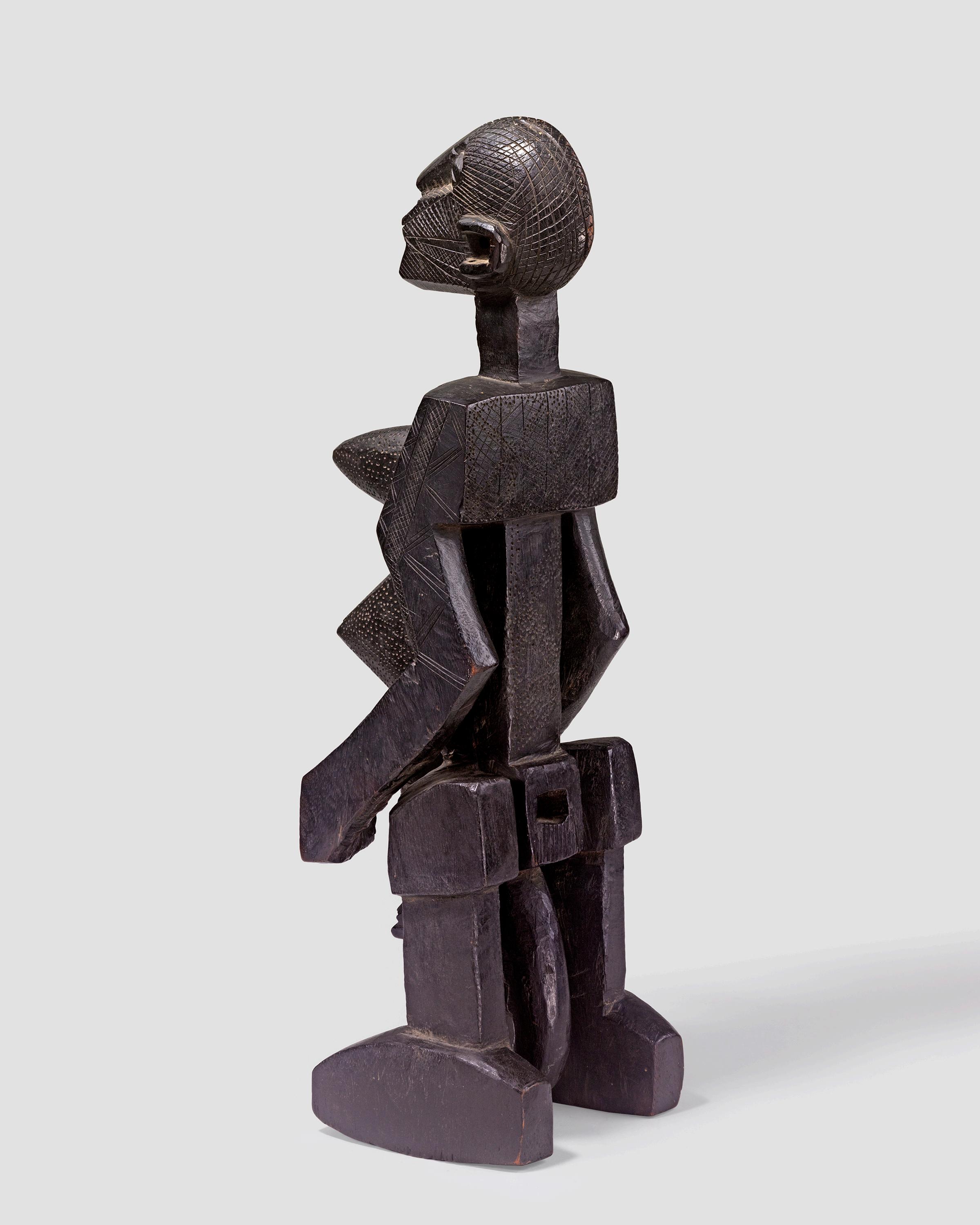
Anthropomorphic Female Power Figure, NKISI
Unidentified Zombo or Sosso Artist, D.R. Congo
Wood, plant fiber, metal alloy, pigment, organic material
H: 35cm
PROVENANCE
Henri Kamer (1927-1992), New York, NY, before 1973
Private Collection, thence by descent, 1992
Sotheby’s, New York, Important Tribal Art, 18 May 1992, lot 188
Collection of Allan Stone (1932-2006), New York, NY
Private Collection, New York, NY
Cole Harrell, New York
LITERATURE
Kamer (Henri), Arte Negra: Prima Mostra a Roma, Rome: Galleria il Silenus, 1973: #128
EXHIBITED
Rome, Italy, Arte Negra, Galleria il Silenus, 1 October-24 October 1973
CF Phelps (Steven), Art and Artifacts of the Pacific, Africa and the Americas: The James Hooper Collection, London: Hutchinson, 1976:397, plate 240, #1853
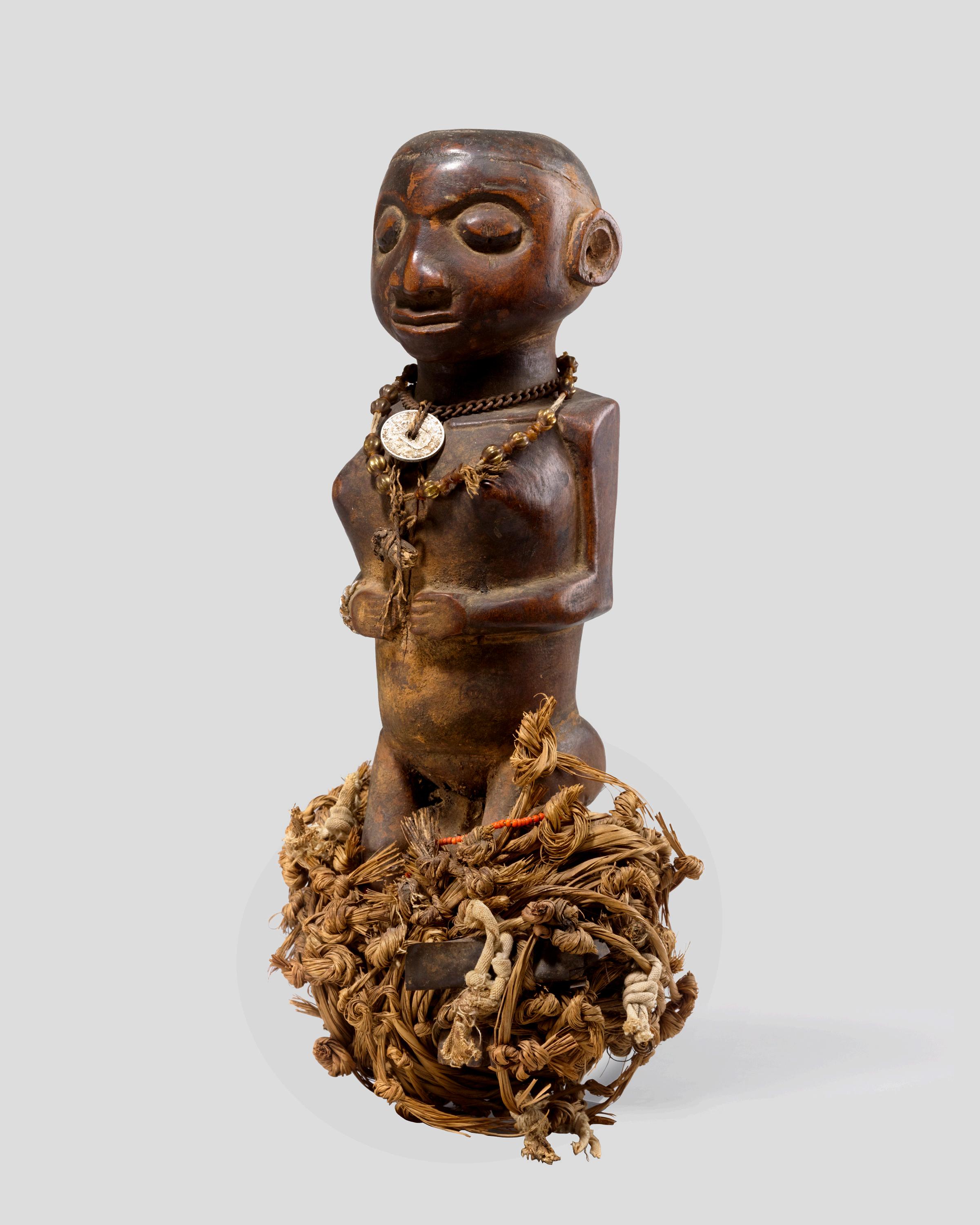
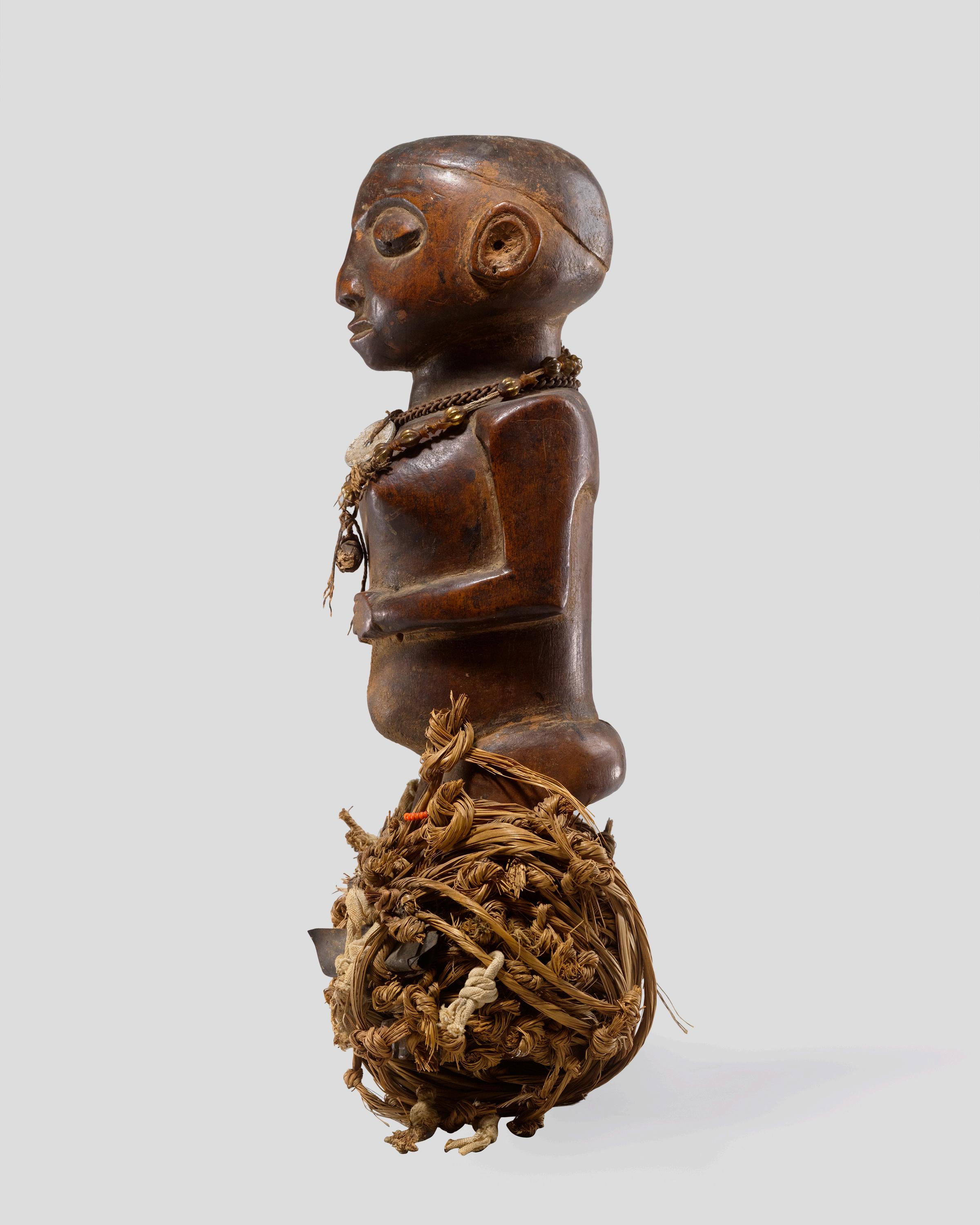
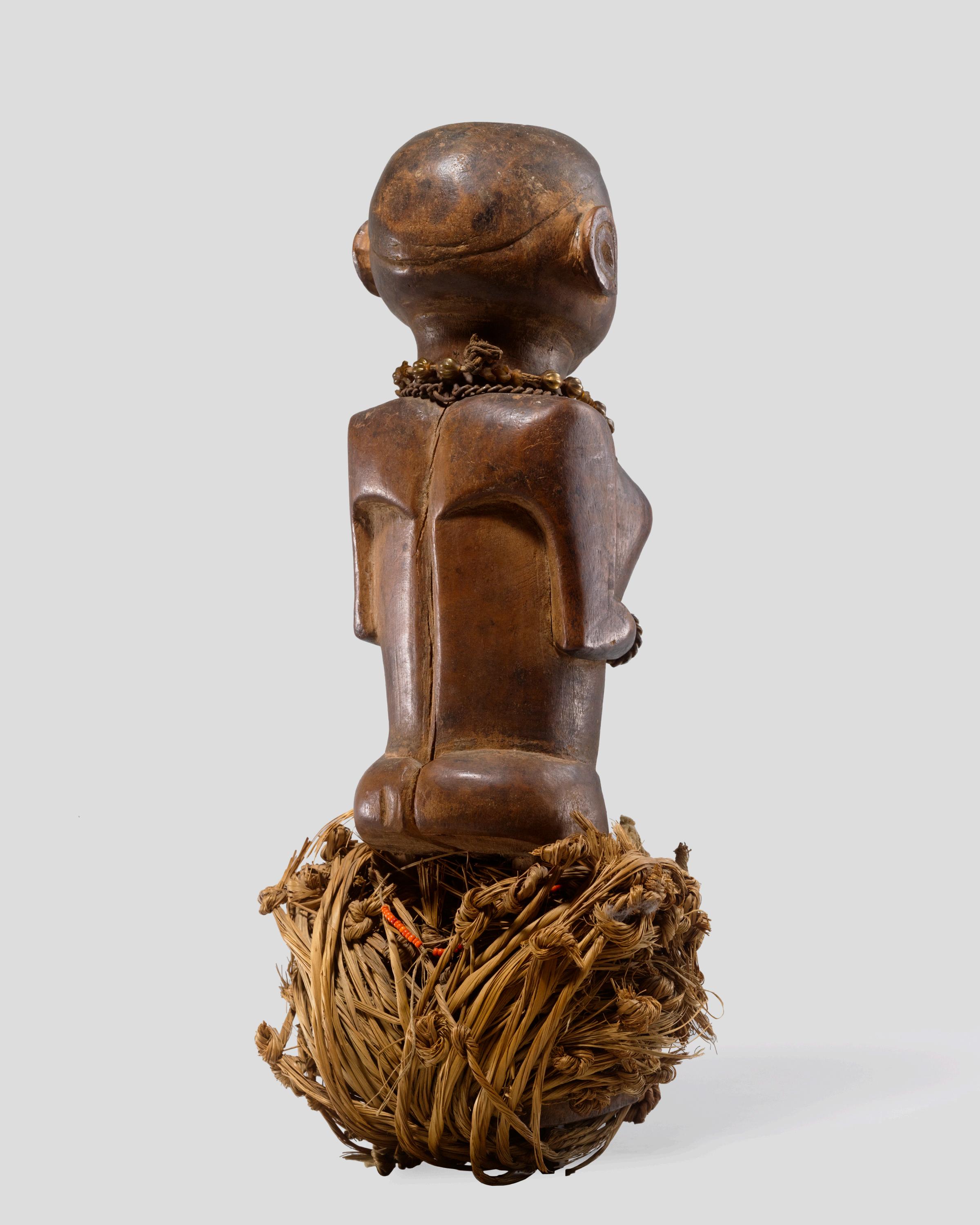
Anthropomorphic Female Prestige Stool, KIHONA
Unidentified Luba-Zela Artist, D.R. Congo
Wood H: 54cm
PROVENANCE
Collection of Hans Hess OBE (1907-1975), Basel, Switzerland
Collection of Arnold Bamert (1905-2006), Solothurn, Switzerland, acquired 1980
Distinguished Private Collection, New York, acquired from the above, 2004
Cole Harrell, New York
LITERATURE
Bamert (Arnold), Laude, (Jean), Afrika. Stammeskunst in Urwald und Savanne, Olten: Walter Verlag, 1980:270, #181
Bamert (Arnold), Laude, (Jean), Africana. L'art tribal de la forêt vierge et de la savane, Paris: Herscher, 1980:270, #181
Bamert (Arnold), Laude, (Jean), Africa: Tribal Art of Forest and Savanna, London: Thames & Hudson, 1980:270, #181
Expo cat.: Afrika: Maske und Skulptur, by Schaedler (Karl-Ferdinand), Olten: Historisches Museum Olten, 1989: #98
Schaedler (Karl-Ferdinand), Lexikon Afrikanische Kunst und Kulter, Munich: Klinkhardt und Biermann, 1994:404. Schaedler (Karl-Ferdinand), Encyclopedia of African Art and Culture, Munich: Panterra, 2009: 637
EXHIBITED
Olten, Switzerland: Afrika. Maske und Skulptur, Historisches Museum Olten, 26 August-15 October 1989
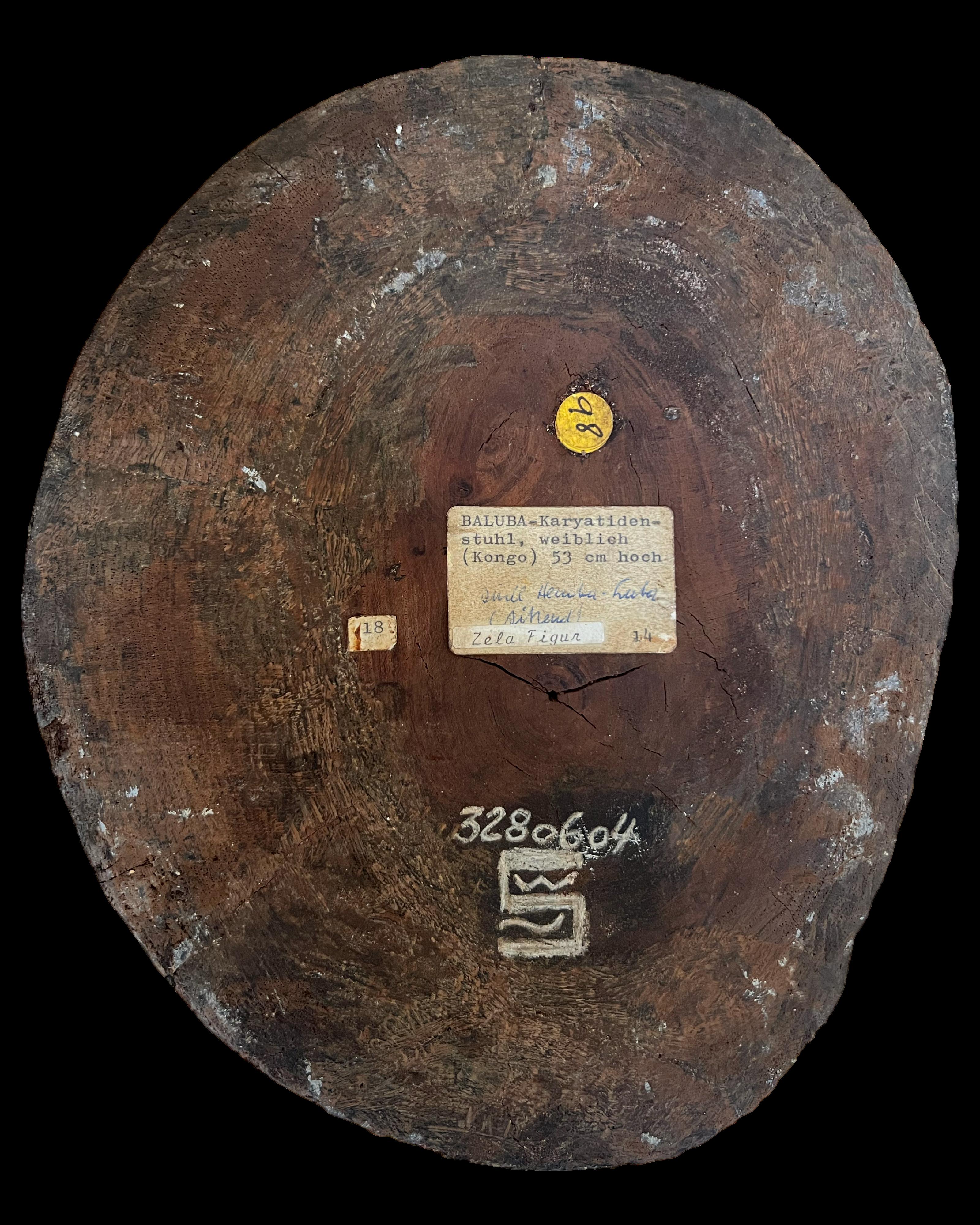
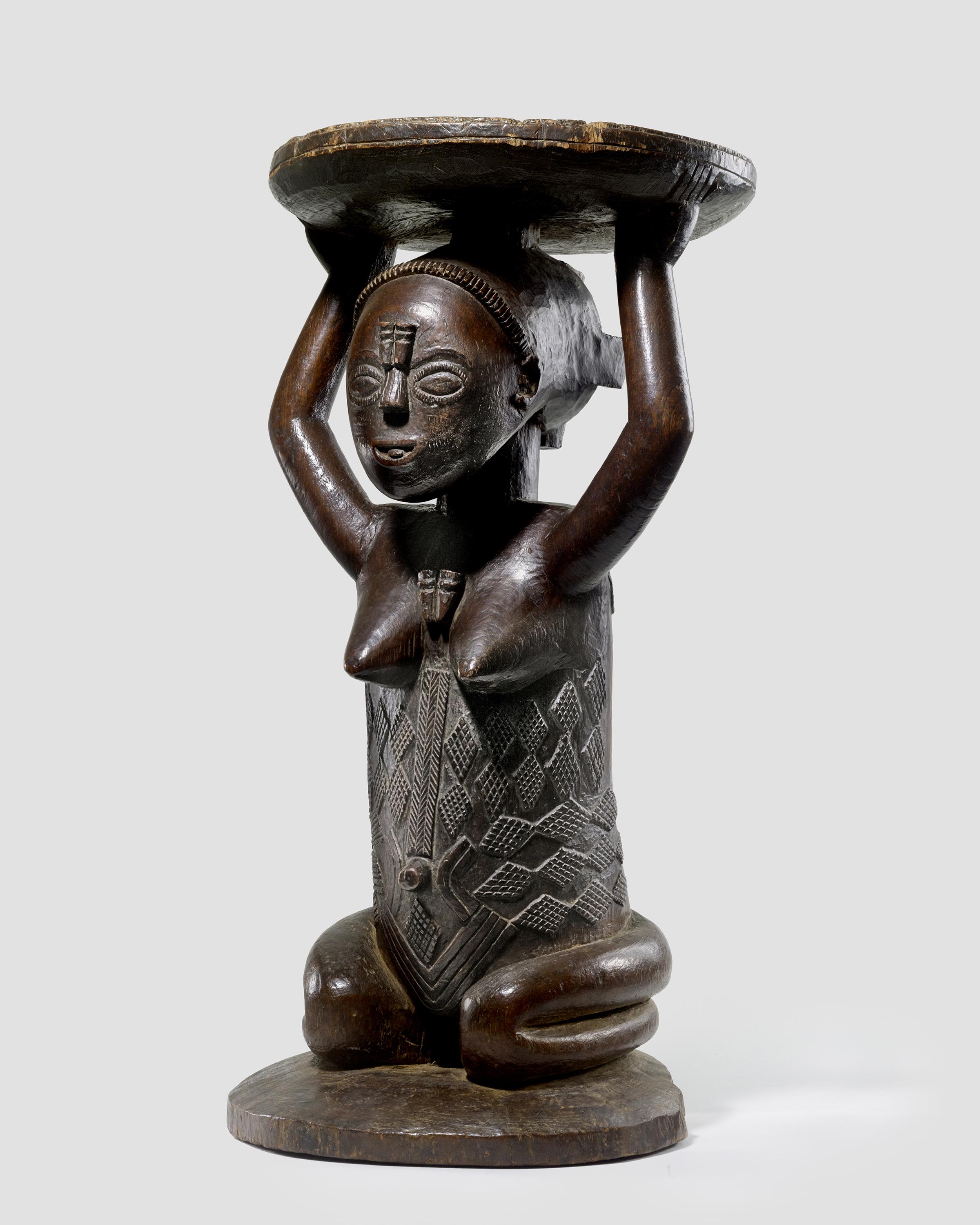
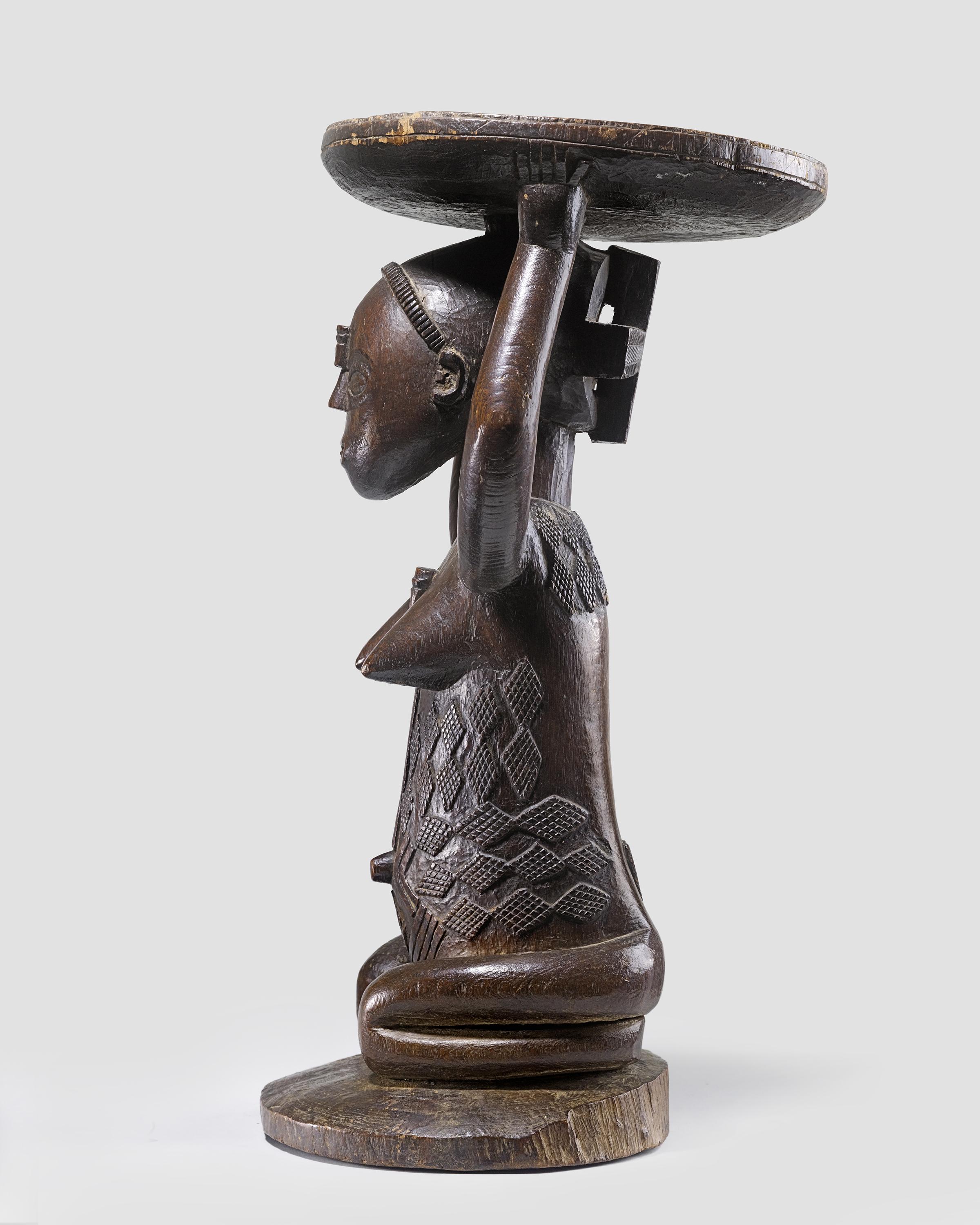
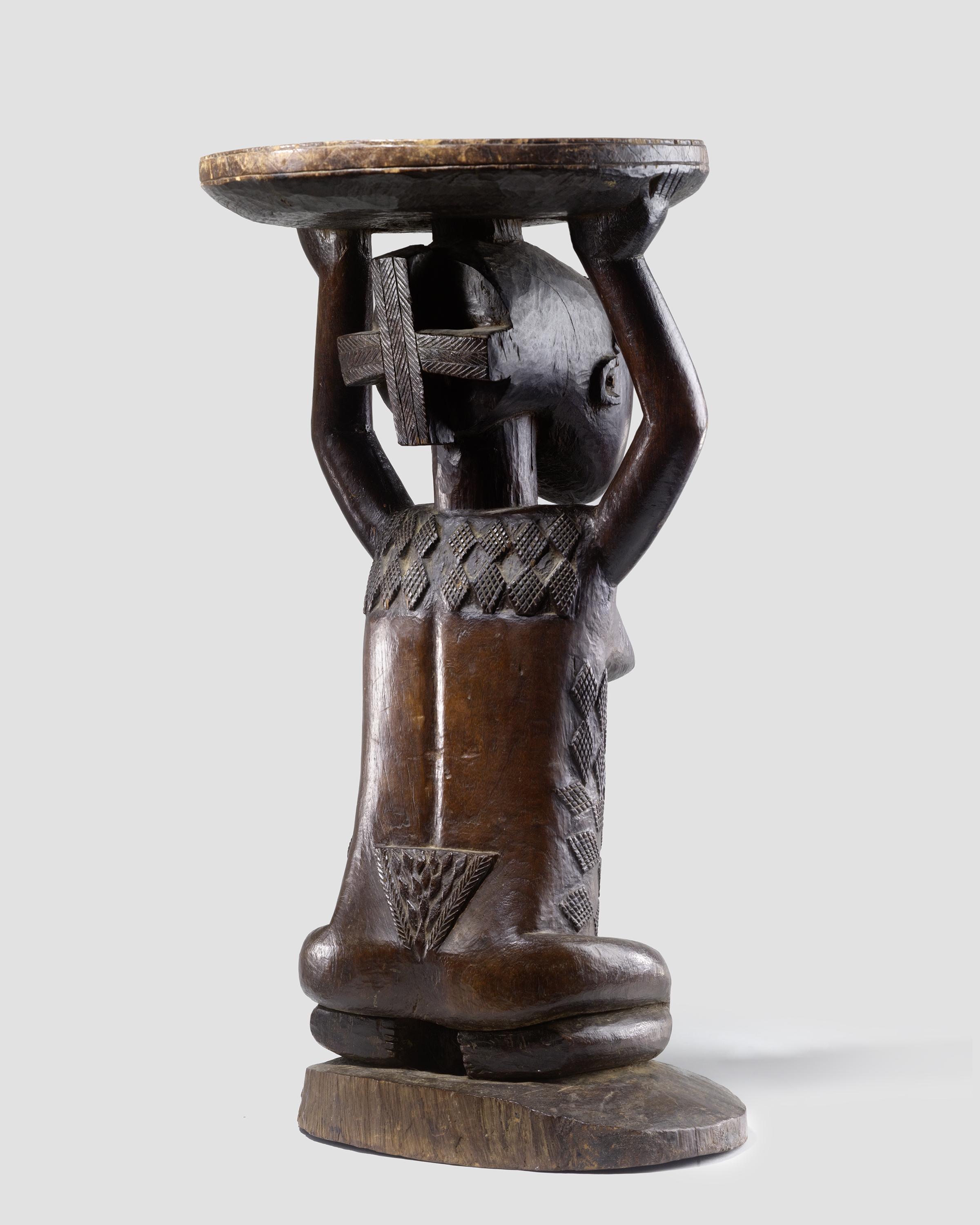
Anthropomorphic Female Power Figure, NKISI
Unidentified Bwende Artist, D.R. Congo
Wood, pigment, beads, textile, iron alloy, organic material
H: 22cm
PROVENANCE
Collection of Jacques Deprince, Brussels, by 1983
Jacques Hautelet (1931-2014), Brussels, acquired from the above, 1983
Collection of Robert Aaron Young, New York, Baltimore, acquired by 1990
Collection of Shirley (1927-2019), Marshall (1923-2006) Jacobs, Maryland, acquired from the above, 10 October 1990 Collection of Randi Jacobs (1955-2021), Maryland, thence by descent, 2019
Cole Harrell, New York
LITERATURE
Neyt (François), Arts traditionnels et histoire au Zaire/Traditional Arts and History of Zaire, Louvain-le-Neuve, Université Catholique de Louvain, 1981:103, #V.18
Expo cat.: Perspectives: Angles on African Art, Vogel (Susan), editor, New York: The Center for African Art, 1987:191 Lehuard (Raoul), Art Bakongo. Les centres de style, Paris: Arts d'Afrique Noire, vol. 1, 1989: 189, #B 4-3
EXHIBITED
United States, Perspectives: Angles on African Art
- Richmond, Virginia: The Virginia Museum of Fine Arts, 21 February-26 April 1987
- San Diego, California: San Diego Museum of Art, 23 May-16 August 1987
- New York: The Center for African Art, 18 September 1987-3 January 1988
- Birmingham, AL: The Birmingham Museum of Art, 31 January-27 March 1988
“Now this is a splendid thing...that awesome juxtaposition of life and medicine warns us that this image must have been used to protect not just a single person but a community.”
- Scholar Robert Farris Thompson (1932-2021), writing about the present figure, 1987
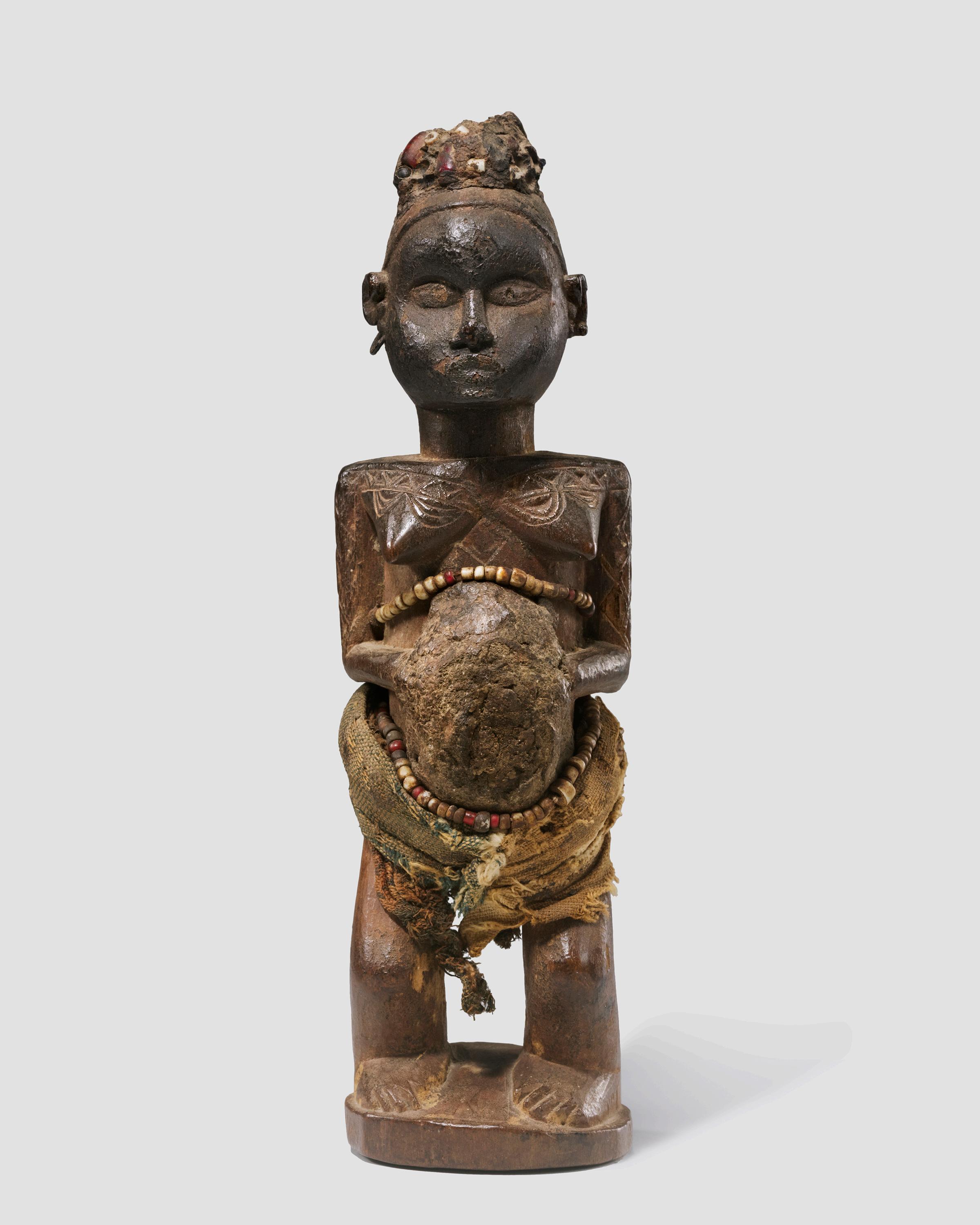
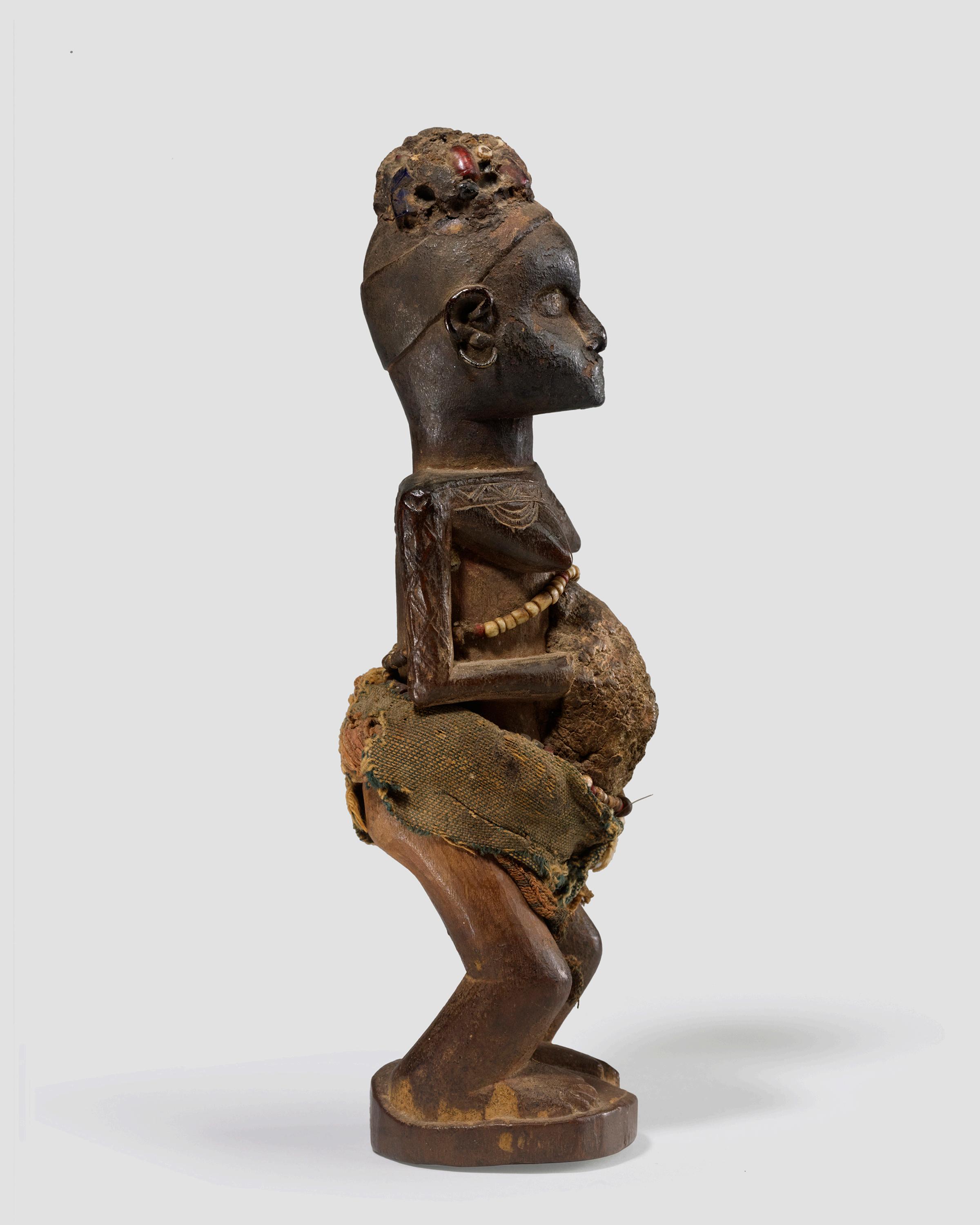
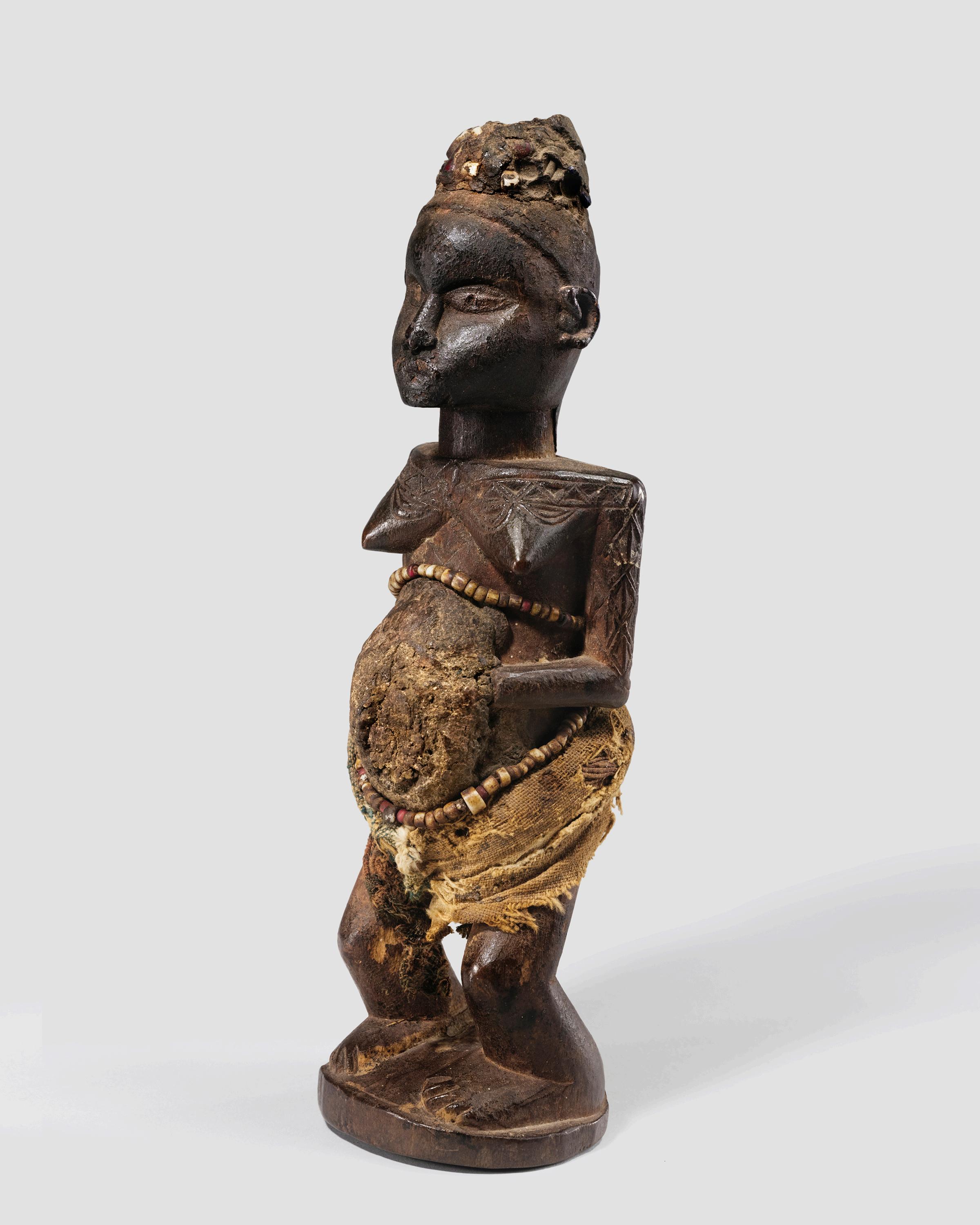
Anthropomorphic Female Figure, NKISI
Identified Songye-Tempa Artist, D.R. Congo, Sankuru Province
Wood H: 29cm
PROVENANCE
Private Collection, Greenwich, CT
Cole Harrell, New York
CF
Royal Museum for Central Africa, Tervuren, Belgium, inv. 18804 (acquired in situ by E. de Deken in 1887)
Neyt (François), Songye. La Redoutable Statuaire Songye d'Afrique Centrale/Songye. The Formidable Statuary of Central Africa, Antwerp: Mercatorfonds, 2004:259, #226
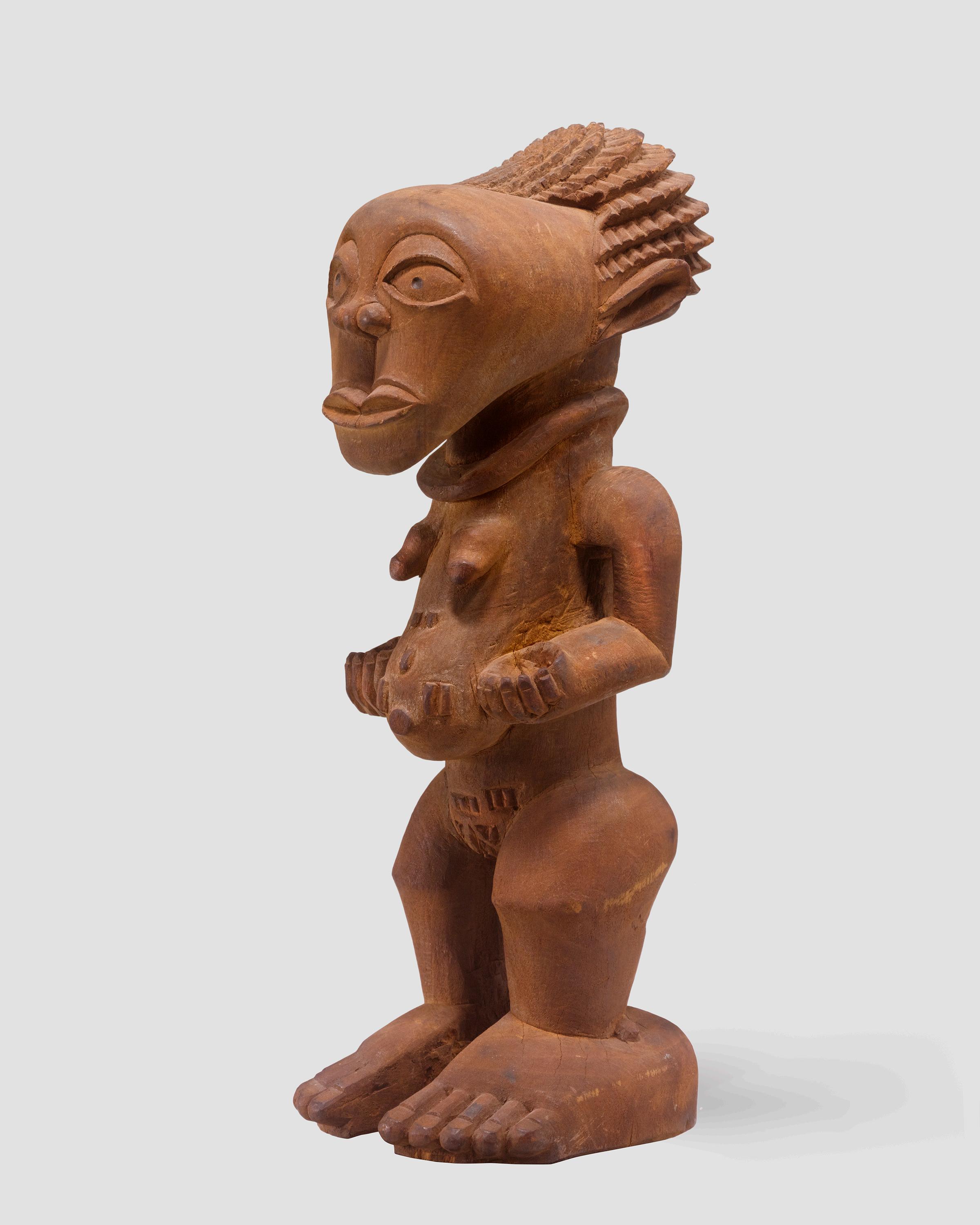

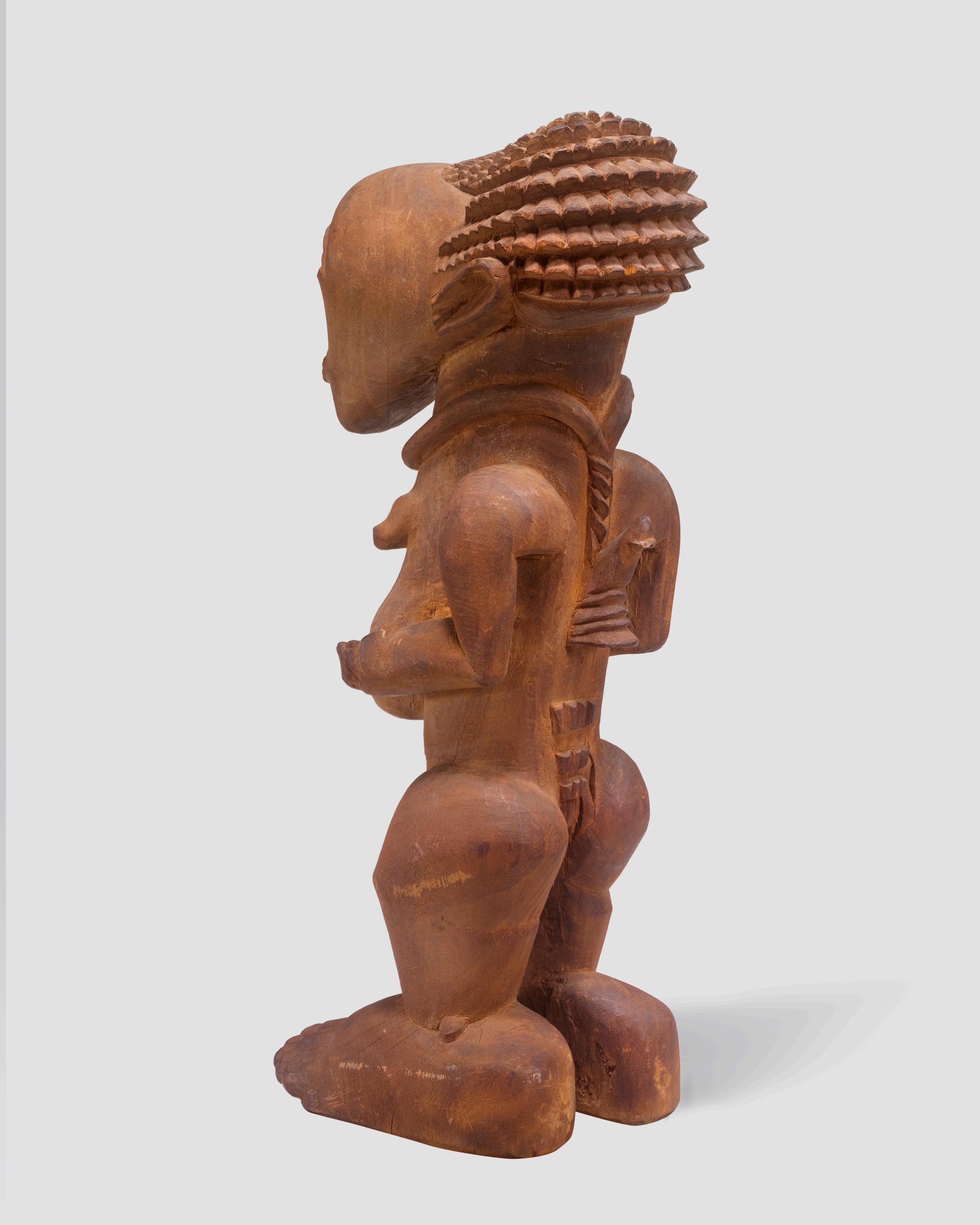
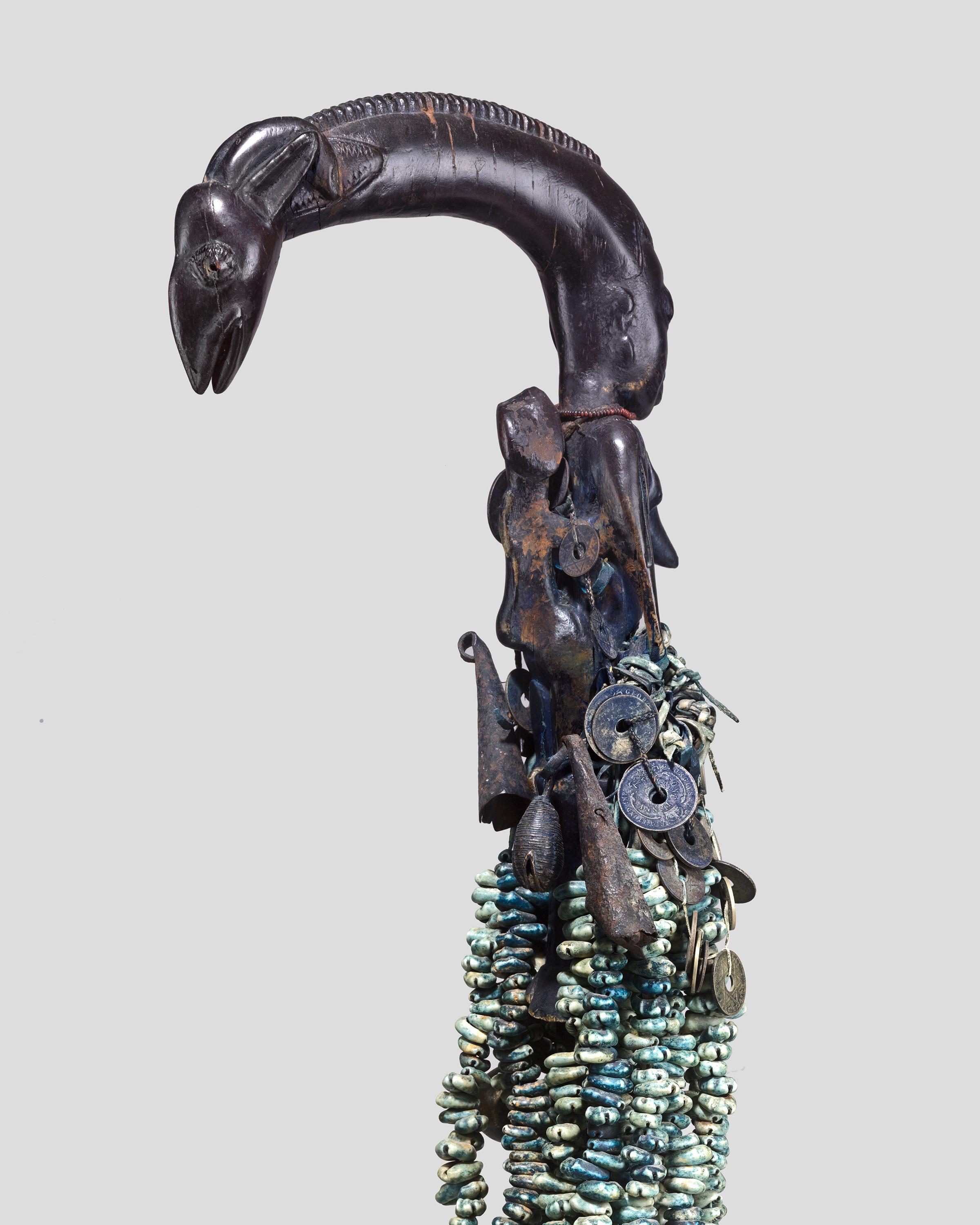
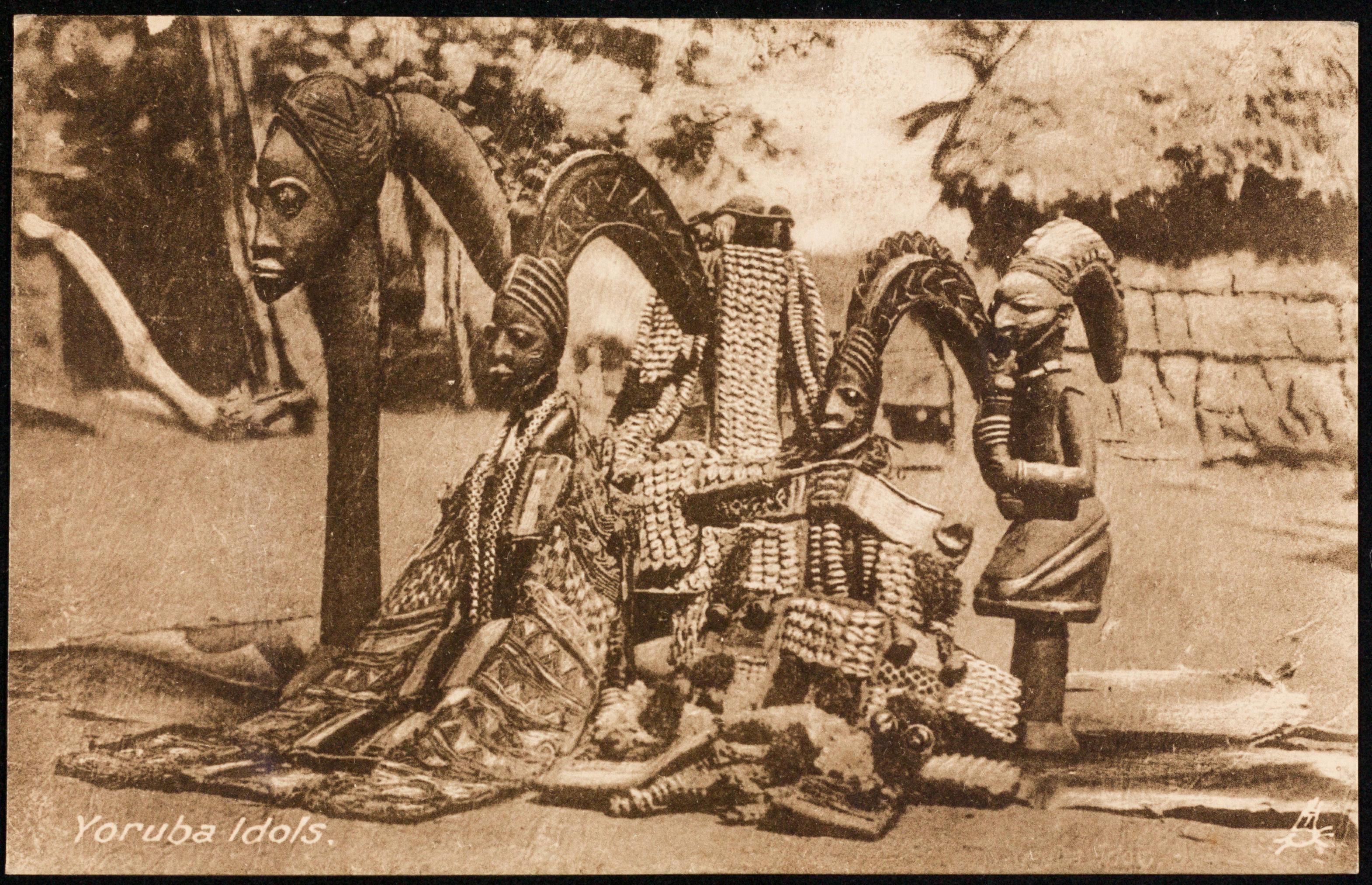

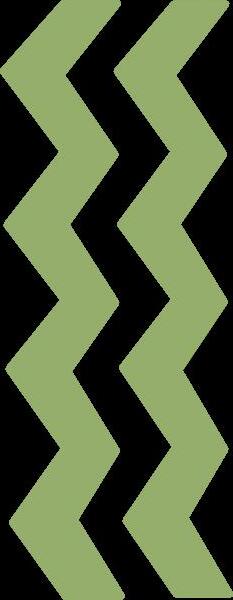

Anthropomorphic Female Ceremonial Staff, OLO ELAGBA
Unidentified Yoruba Artist, Igbomina, Nigeria
Wood, natural indigo pigment, metal alloy, cowrie (cyprea moneta), leather, twine H: 64cm
PROVENANCE
Collection of Christina and Rolf Miehler, Munich, Germany
Pace Primitive, New York, USA, by 1993
Distinguished Private Collection, New York, USA, acquired from the above Cole Harrell, New York
LITERATURE
George Chemeche, Eshu: The Divine Trickster, Woodbridge, Suffolk:Antique Collectors' Club, 2013:204-205
CF
Expo cat.: African Art, Detroit: Donald Morris Gallery, 1971: #25 (Collection of Morris W. Stein by 1971)
Preceding Overleaf
Yoruba Idols by Raphaël Tuck & Sons, circa 1920
The Church Missionary Society, Lagos
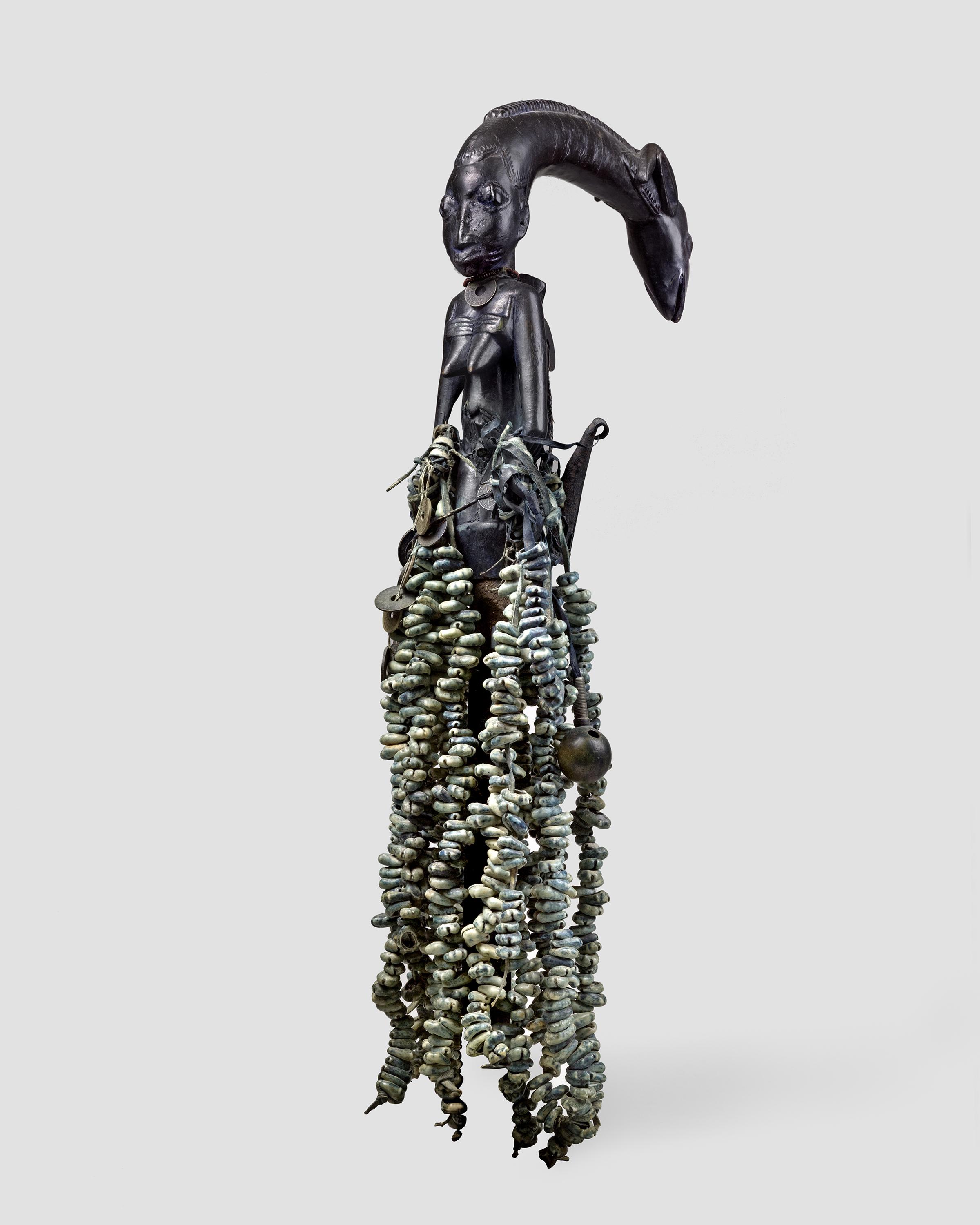
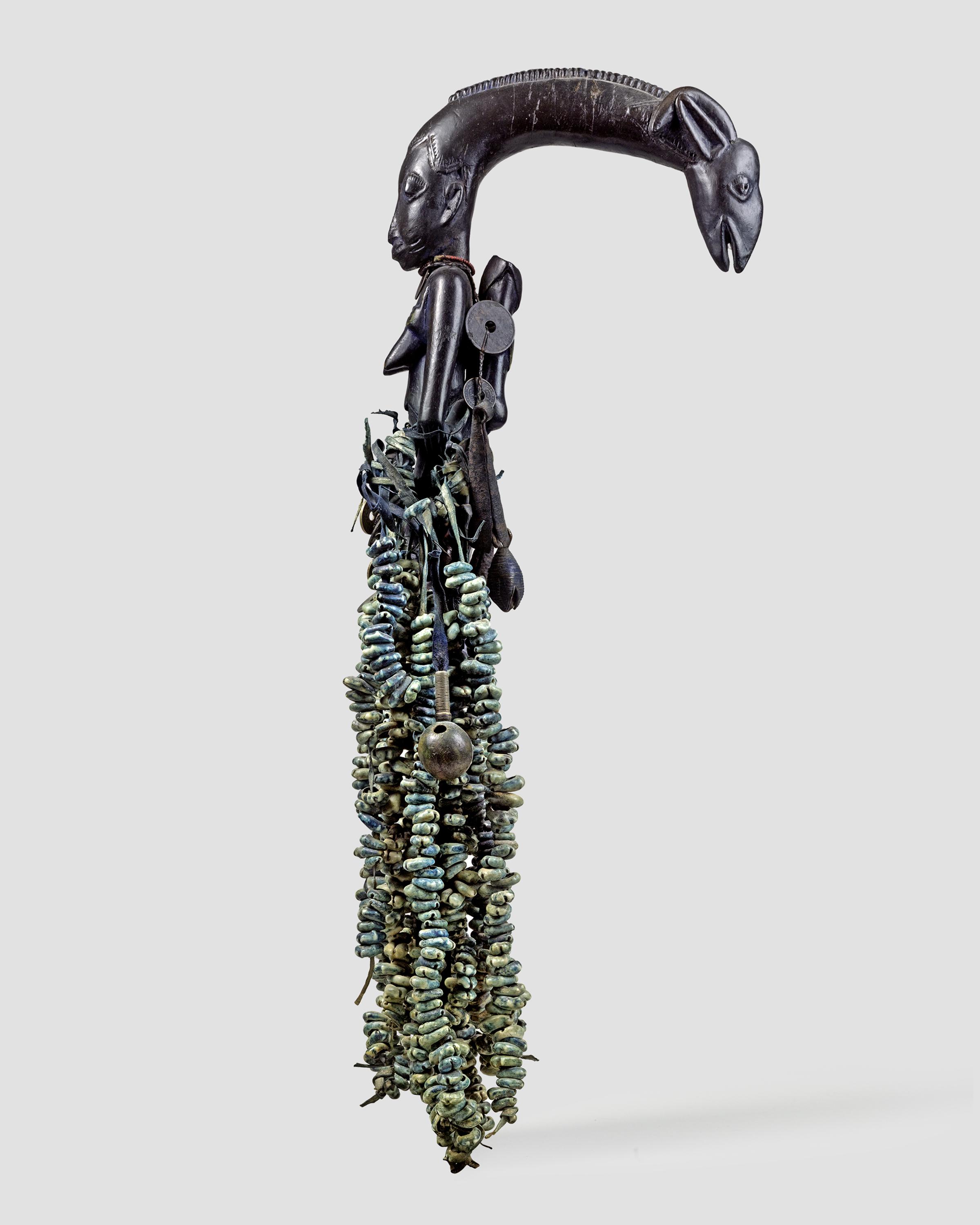



Produced in conjunction with the exhibition
FEMME; Celebrating the Feminine Through Classical African Sculpture
Presented by Cole Harrell/ Harrell Fine Art, New York 16 May – 30 June 2024
LAYOUT ...........Cole Harrell PHOTOGRAPHY ................................................Edward Parrinello
ACKNOWLEDGEMENTS
Edwin Badia
Dr. Tai-Heng Cheng
Julianne Cross
Jason Goudreau
Professor François Mottas
Aurore Mariani
Dr. Amanda Maples
Ariane Powell
Guy van Rijn
Titus van Rijn
Victor Teicher
Marie-Noël Verger-Fèvre
Maureen Zarember
Dr. David Zemanek
HARRELL FINE ART
Cole Harrell, Director



